Review Summary
Best 2TB SSD?
XPG Gammix S70 Blade 2TB NVMe SSD is a no-brainer with its high performance, better value, PS5 compatibility, and comprehensive software. It is a must-have for the gamers and the enthusiasts for what it offers on the table. It comes recommended by us.
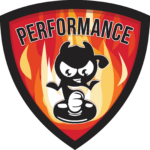
Overall
-
Quality - 9/10
9/10
-
Performance - 9.5/10
9.5/10
-
Features - 9/10
9/10
-
Value - 9.5/10
9.5/10
Pros
- 7400MB/s Sequential Read
- 6800MB/s Sequential Write
- PS5 Compatibility
- Dedicated Heatsink Cover
- 5-Year Warranty
- Real World Performance
- Price
Cons
- None
In our last take, we took a spin at Sabrent Rocket 4 Plus G 2TB NVMe SSD. This time, we are taking a look at another NVMe SSD. It is XPG Gammix S70 Blade 2TB. Quite long names there! At least Teamgroup did fine naming their products like MP44. That simple! Anyhow, coming back to the main topic, the XPG Gammix S70 Blade series is a high-end NVMe SSD solution from the manufacturer, particularly aimed at gamers. The feature is quite long here:
- R/W speed up to 7,400/6,800MB/s for PC/Laptop
- Ultra-fast PCIe Gen4 x4 interface
- Compliant with NVMe 1.4
- Works with PS5
- Read speed up to 6,300MB/s for PS5
- High-temperature resistant aluminum heat sink, which is able to reduce temperatures by up to 20%
- Capacity up to 4TB
- SLC Caching and DRAM cache buffer
- Advanced LDPC ECC Technology
- E2E Data Protection and RAID Engine
- AES 256-bit encryption support
- Compact M.2 2280 form factor – ideal for gaming and high-end desktops
I have highlighted three critically important features of this SSD that we often don’t see in competition. Good job, team XPG. Talking about the performance numbers, the 2TB variant is rated for up to 7400 MB/s in sequential read and up to 6800MB/s in sequential write. The 4K Random reads and writes are at 750K with a 1480 TBW rating. I can see this SSD straight going up against the MP44 in terms of performance numbers, though none of the other SSDs, including this XPG SSD, has enough TBW rating to challenge the MP44.
Key Takeaways
- The XPG GAMMIX S70 BLADE 2TB NVMe SSD impresses with its lightning-fast speeds, boasting a staggering 7400 MB/s, ensuring swift data transfers and reduced load times.
- SSD Tool Box provides users with valuable tools to optimize and maintain their drive, enhancing overall usability.
- Beyond the specs, the SSD delivers remarkable real-world performance, making it an excellent choice for those seeking both speed and reliability in their storage solution.
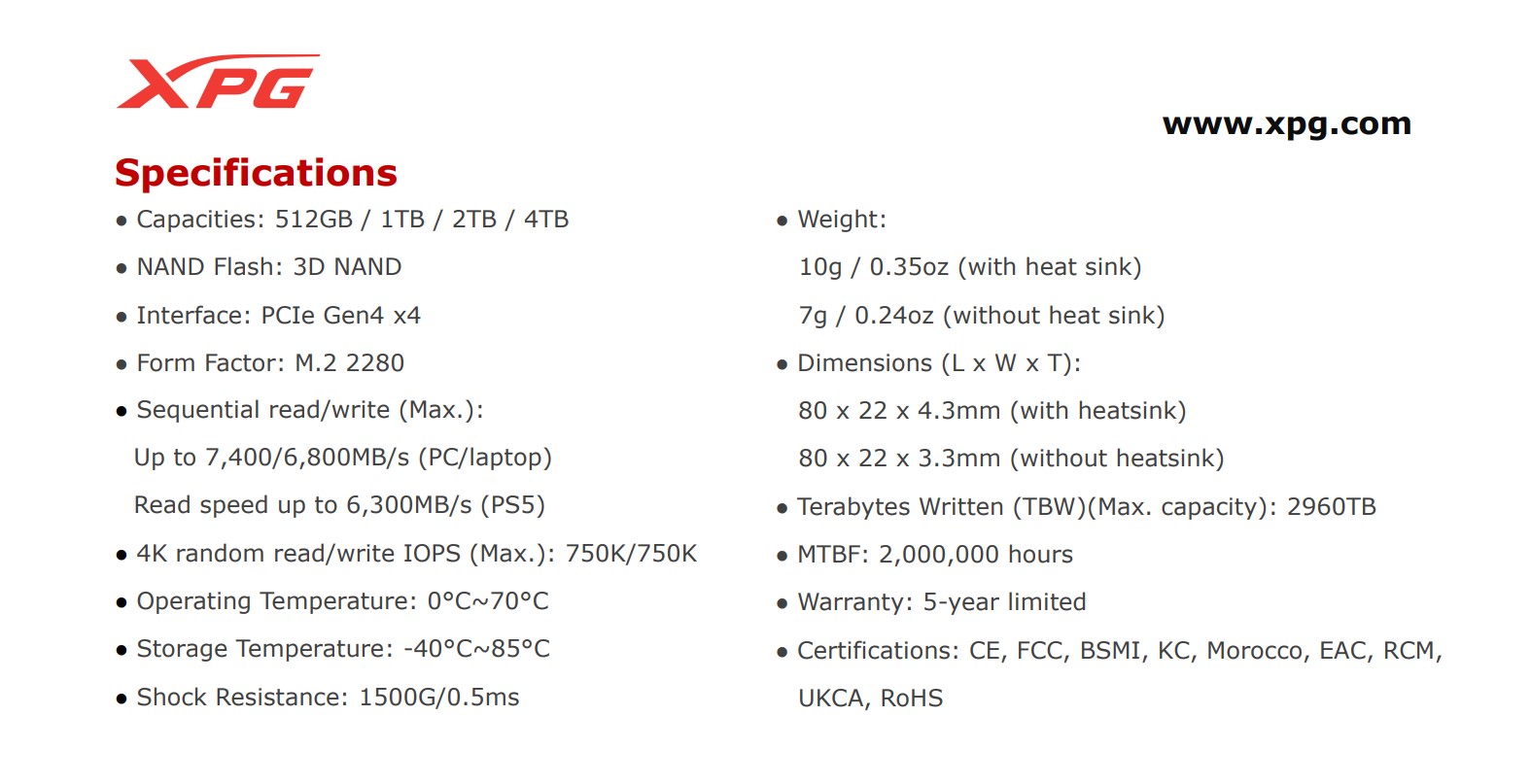
Packaging and Unboxing
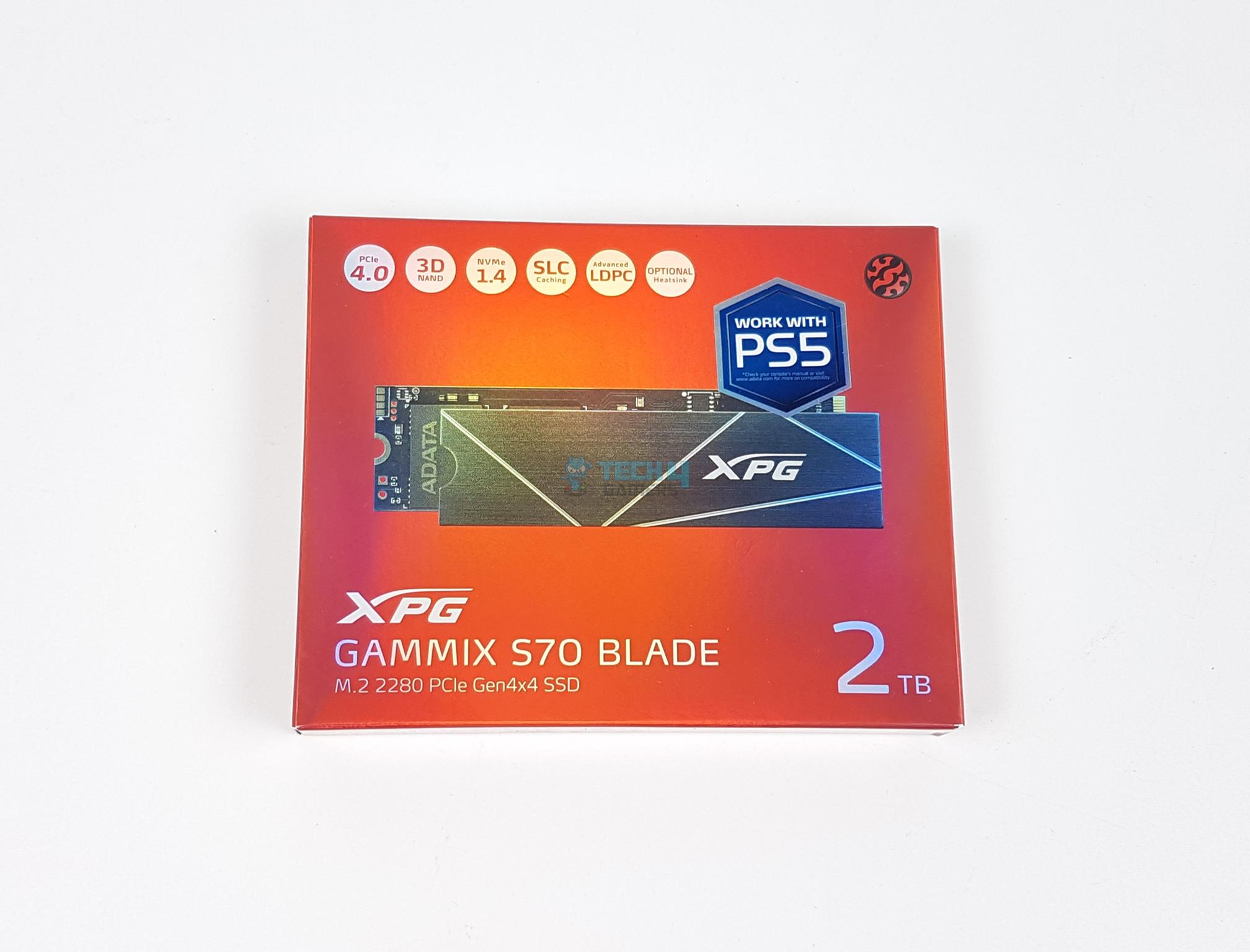
The SSD is shipped inside a red color box that is made of paper board. This is a standard XPG-themed packaging. One thing we can see over the front is the emphasis on PS5 compatibility. We have seen many vendors releasing PS5-compatible (dimension-wise) NVMe high-capacity fast storage solutions.
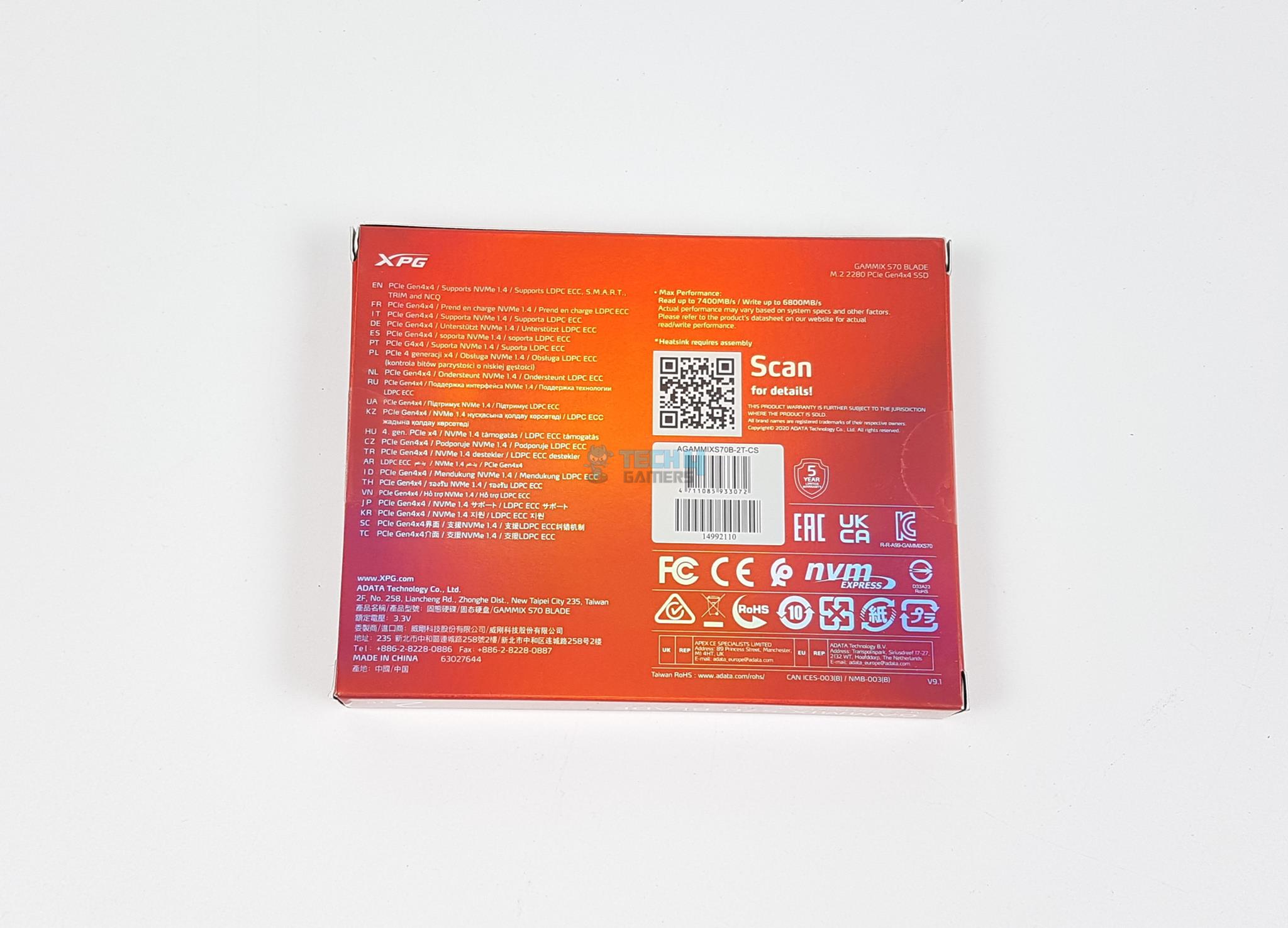
AGAMMIXS70B-2T-CS is a part number of this SSD. The performance numbers of this SSD are also printed over here. XPG has mentioned that they have tested the SSD on the X570 platform. It is compliant with the NVMe 1.4 interface using PCIe 4×4 protocol.
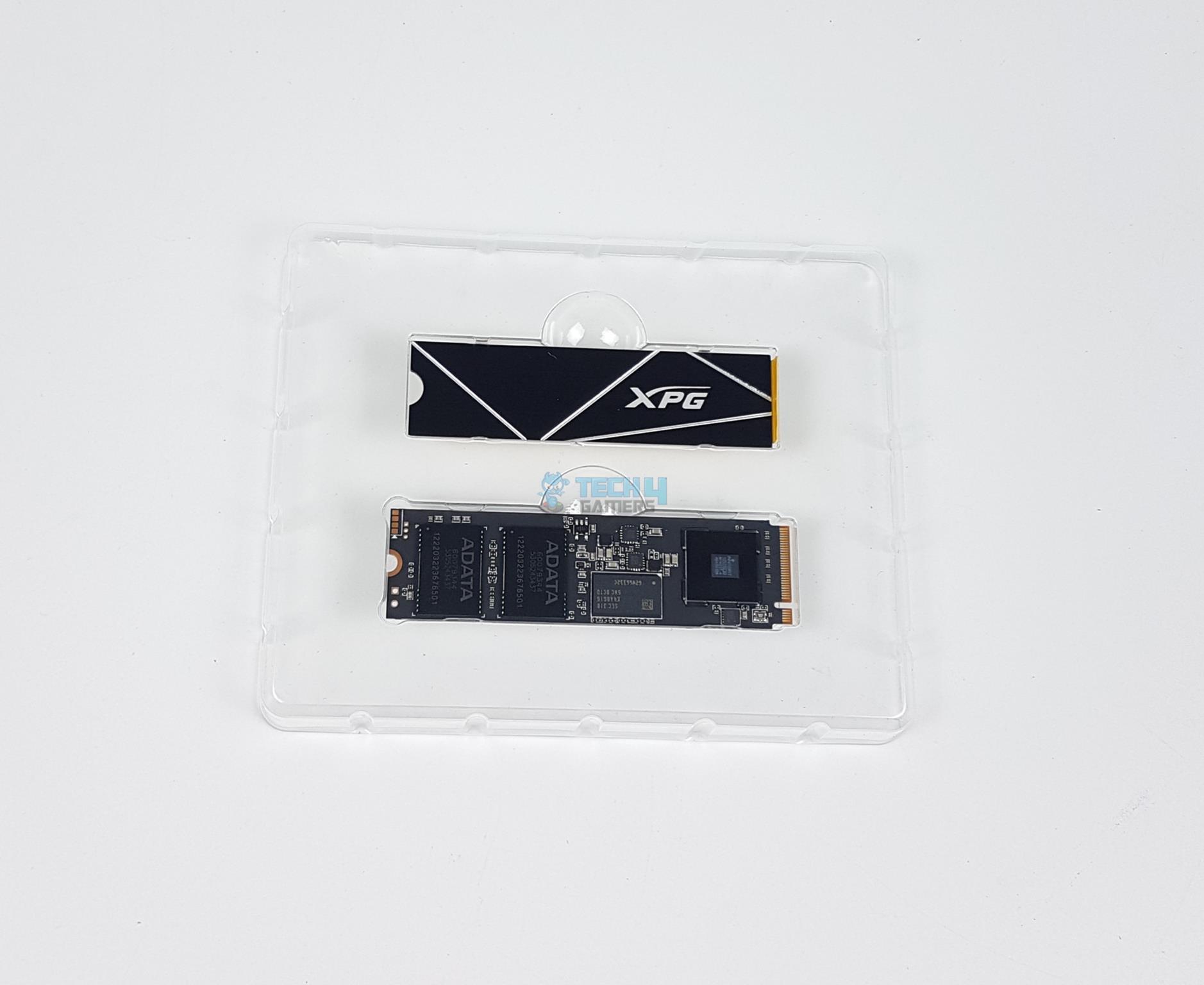
Inside the main packaging box, there is a transparent container that has two insets. The SSD is placed in one inset, whereas the heatsink is placed in the other inset. I appreciate XPG’s approach here. Instead of providing heatsink installed SSD, they have left it at the user’s disposal so that either the user could use the provided heatsink or simply place the SSD under the motherboard’s heatsink cover.
Design
Let’s start with a statement from XPG about this SSD first. “Enjoy the next-gen performance with the XPG GAMMIX S70 BLADE PCIe Gen4x4 M.2 2280 solid-state drive (SSD). Sporting the latest PCIe Gen4x4 interface and a host of other capabilities, this SSD is capable of reaching blazing-fast read/write speeds of up to 7,400/6,800MB per second.”
The XPG GAMMIX BLADE series is available in the following sizes:
- 512GB
- 1TB
- 2TB
- 4TB
As has been the case with many other NVMe SSDs, the XPG GAMMIX S70 Blade 2TB uses 3D TLC NAND Flash chips, which are probably 176 layered. We know that TLCs store 3 bits per cell compared to other NAND Flash which makes it expensive. The XPG Gammix S70 Blade 2TB has a form factor of 2280 (22×80), and it is an M key type SSD, making it compatible with PCIe M.2 SSD slots on modern motherboards. You can use it on PCIe Gen 3 rated M.2 slots, but that would reduce the performance of the drive, and really, there is not any point in doing that.
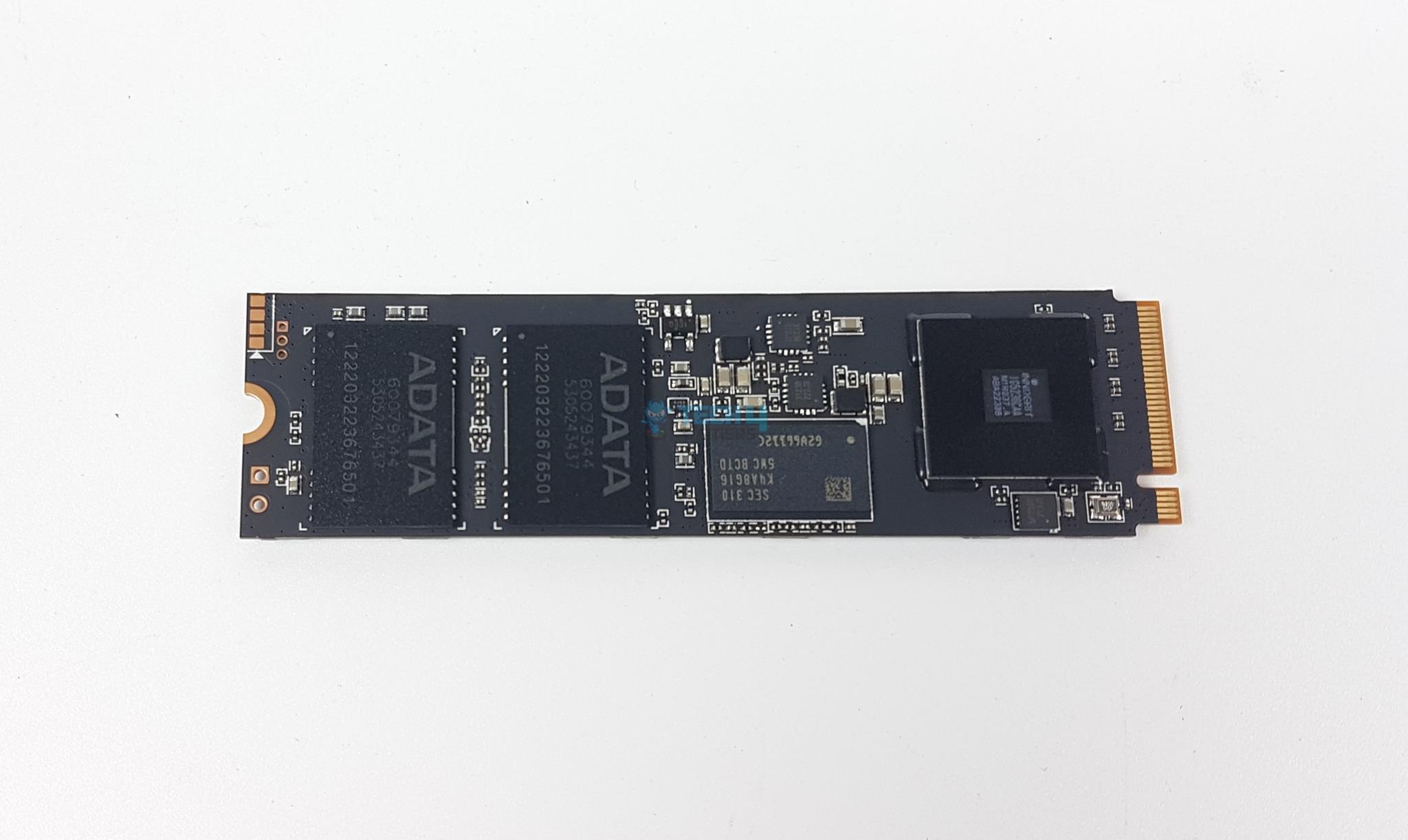
Looking at the at the top, we can see the components since the heatsink does not come pre-installed. The dimension of this SSD is 80x22x3.3mm (LxWxH). The height of 3.3mm makes this SSD compatible with PS5. Bear in mind that this 3.3mm height is with a dual-sided design. After installing the heatsink, the overall height would be 4.3mm, meaning we are adding 1mm to the stock height of the SSD. If I remember correctly, the PS5 has a thickness limitation of 11.25mm for the M.2 SSDs. So, you are good to go after installing the heatsink. XPG has mentioned that the provided heatsink would reduce the temperature by up to 20%. I did not use the provided heatsink to verify this claim. Sorry for that.
So, I was stating that there is no label, no sticker, nothing on the top because the idea is to install the bundled heatsink over the top. It makes me think that XPG did not provide enough solutions because this SSD has a dual-sided design. Anyhow, modern motherboards come with dual heat pads anyway. Since we are at it, let’s go through the components on this drive.
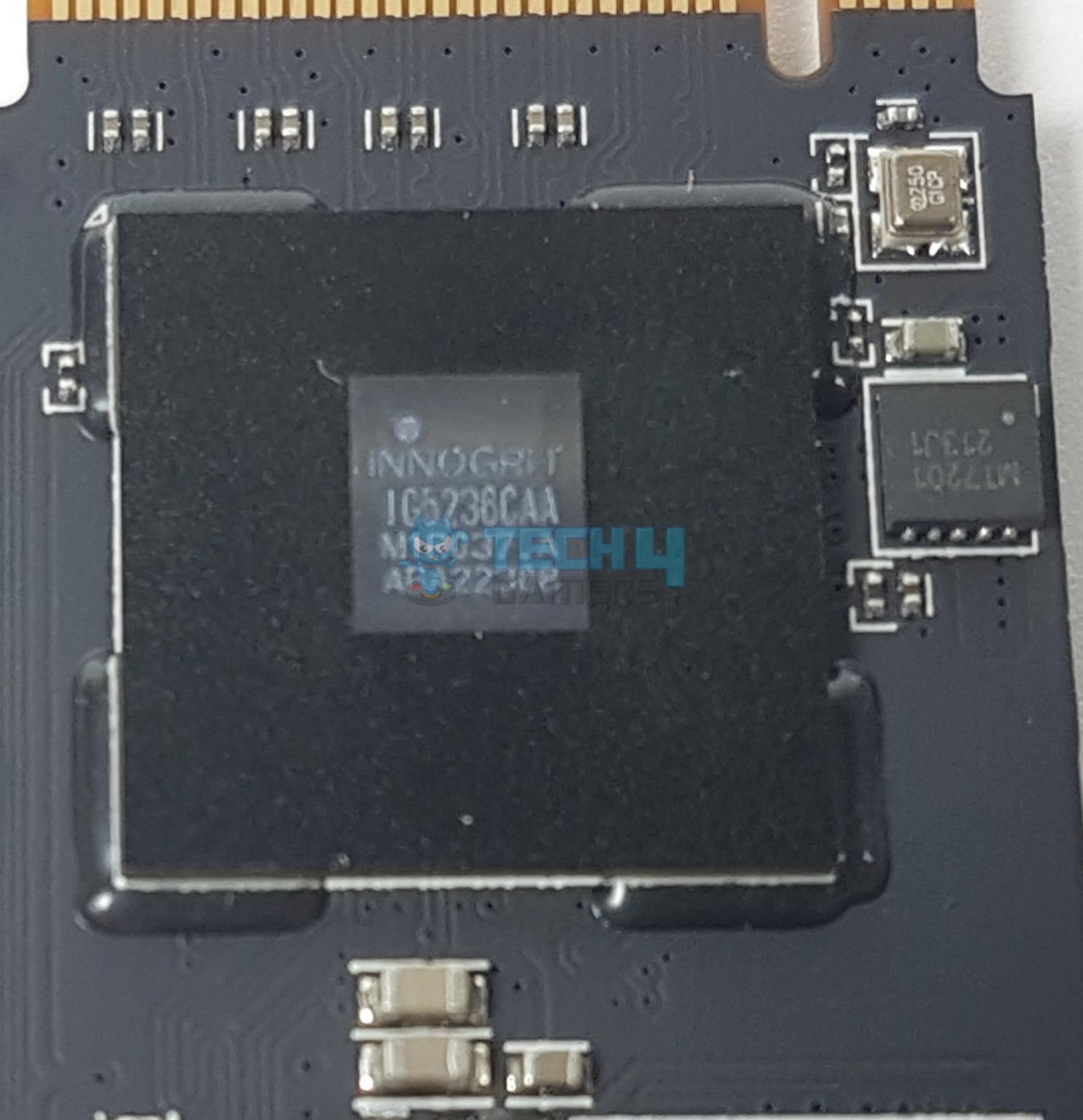
XPG has used the INNOGRIT IG5326 controller on this SSD. This controller is based on a 12nm FinFET process, and it has a 528-ball 14x14mm FCCSP package. This is a PCIe Gen 4 x4 NVMe 1.4 controller, and it supports capacities as high as 8TB and 16TB, depending on the standard package size. It supports DDR SDRAM, and it has eight NAND channels. It has 4 ARM Cortex R5 CPU Cores.
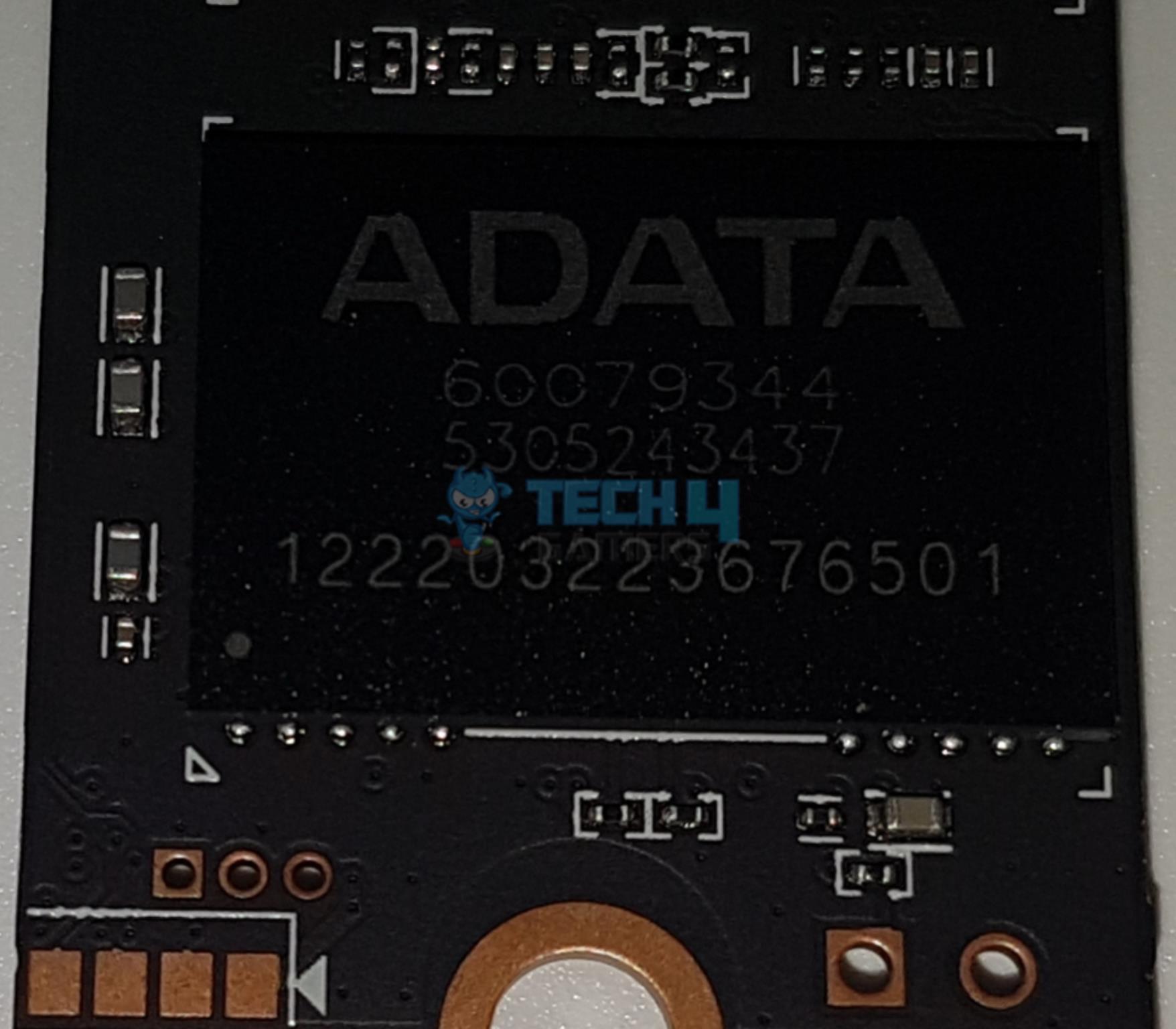
XPG has employed 176-layered 3D NAND TLC Flash chips from Micron. There are a total of 4x NAND flash chips on this drive, with each having a size of 512GB.
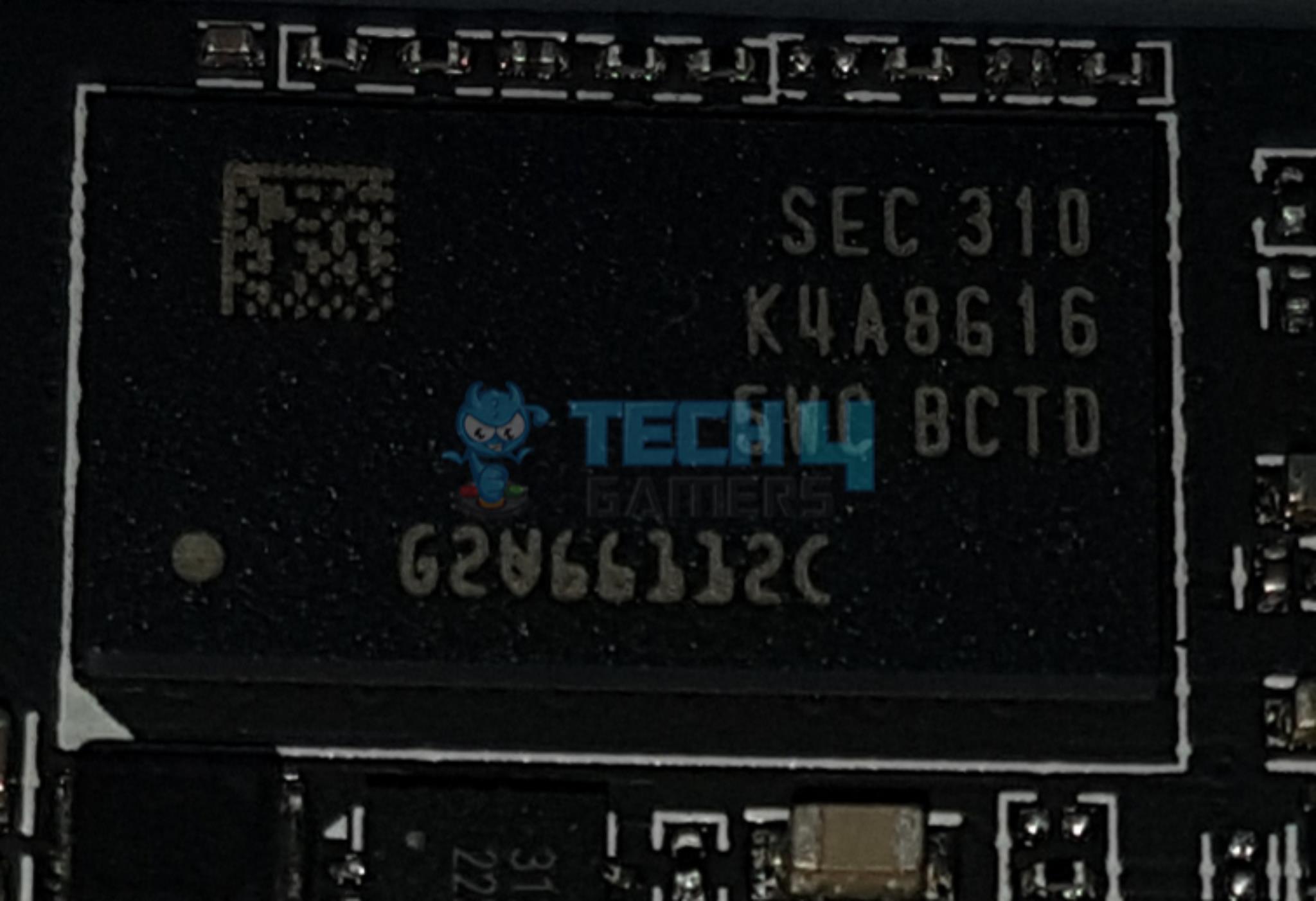
There is a 1GB DRAM Cache chip as well. It is based on DDR4, which syncs well with the IG5326 controller. This chip is from Samsung, and a little online search indicates that it is 2666MHz. There are a total of two DRAM chips on this SSD.
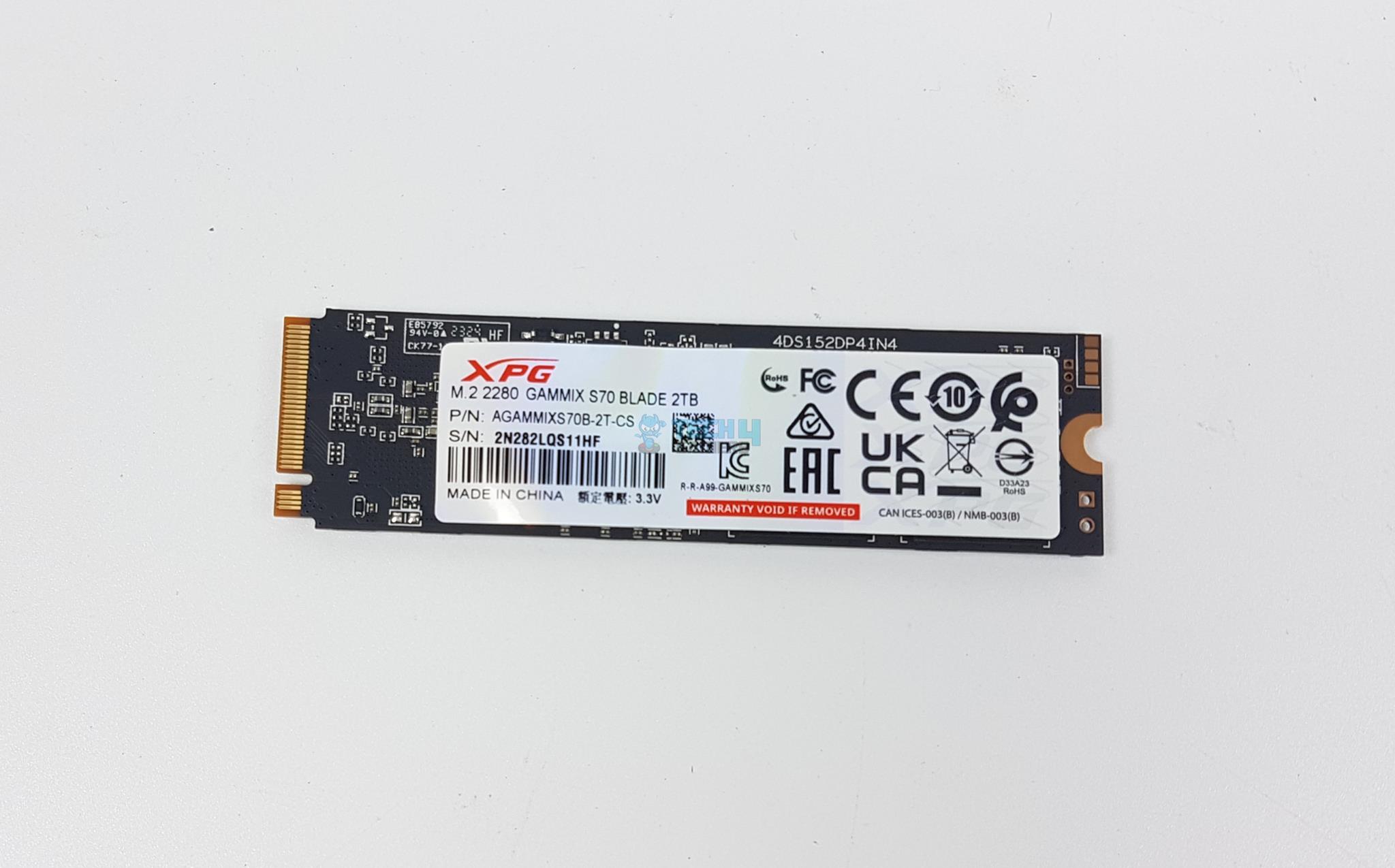
Looking at the backside of the SSD, there is a sticker over here covering the components. There are two NAND Flash and one DRAM chip here. The label has:
- Form factor information of the drive
- A serial number of the drive
- Conformance logos
- Model of the drive
The SSD is made in China. This SSD does not need any NVMe driver as it will use the operating system’s native NVMe drivers. As mentioned above, it is rated for up to 7400MB/s in sequential reads and up to 6800MB/s in sequential writes. On PS5, the sequential read of 2TB SSD will be limited to 6100MB/s, which is a platform limit, not the SSD limit. This SSD is going straight up against the Teamgroup’s MP44 in this category. The 4K Random reads and writes are up to 750K IOPS. The TBW rating is at 1480, which is marginally better than the Sarbent drives but out of proportion when compared with the 2500 value of MP44.
This SSD has a weight of 7g without a heatsink. It has a weight of 10gm with the heatsink. The operating temperature range is 0 to 70°C. The storage temperature limit is -40°C to 85°C. The shock resistance is 1500G/0.5sms. MTBF rating is 2,000,000 hours.
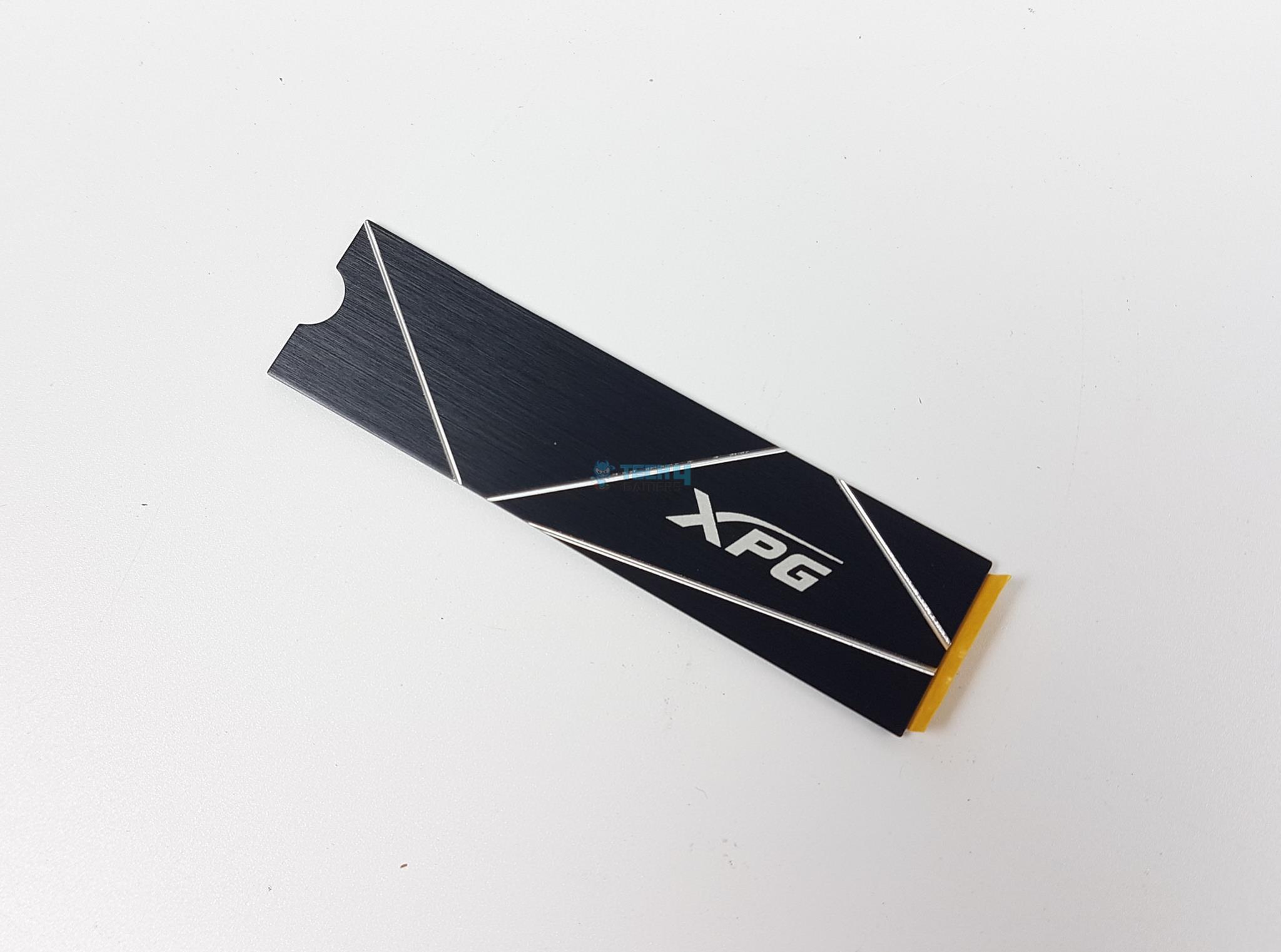
XPG has bundled a stylish aluminum-made 1mm thick heatsink cover with the SSD. It has a lining pattern over the top. These lines are actually insets. There is an XPG brand logo on the right side. This side will face the M.2 port.
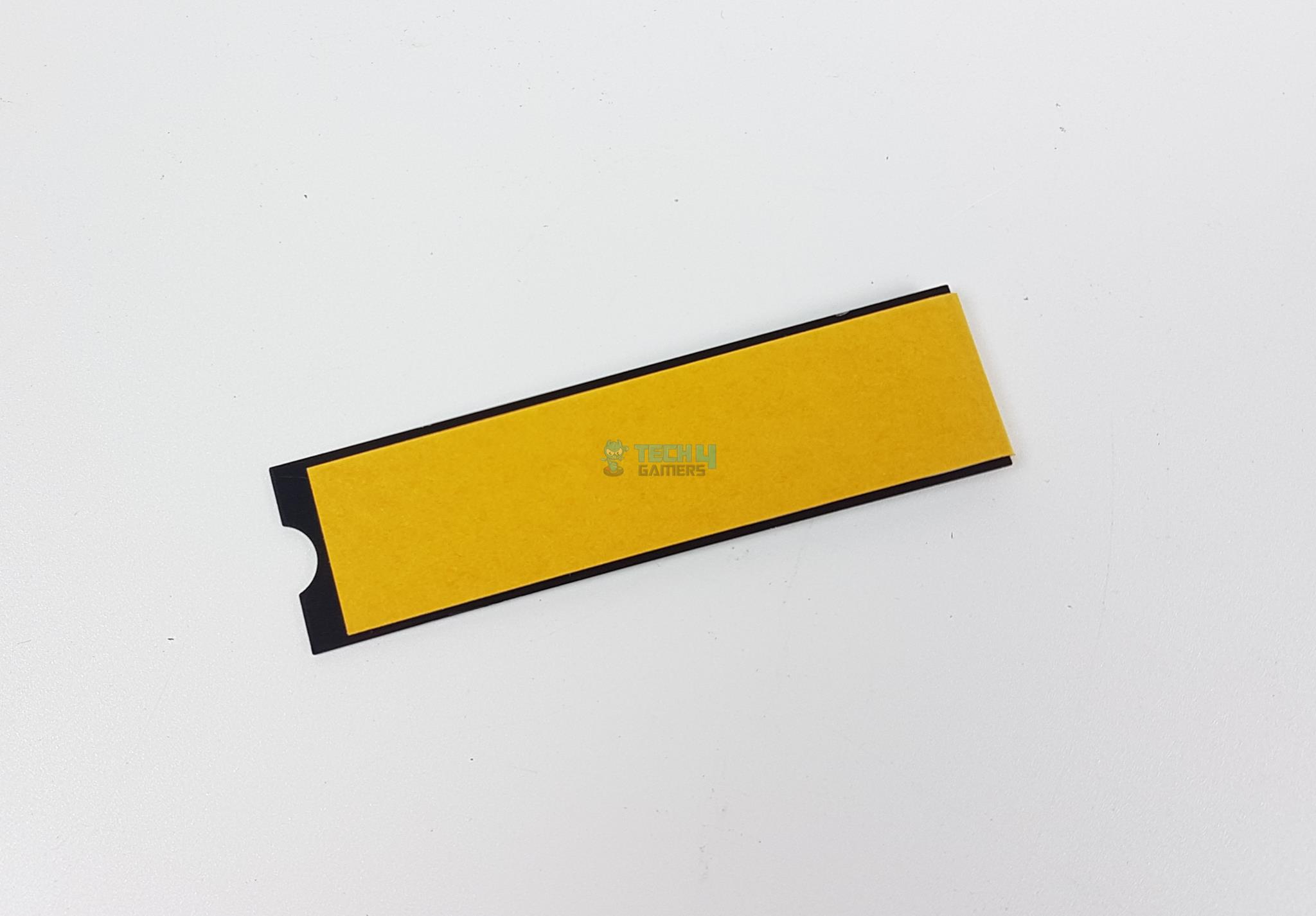
There is a 0.5mm thick thermal pad on the heatsink cover. Don’t forget to peel off the protective cover before installing the heatsink cover on the SSD.
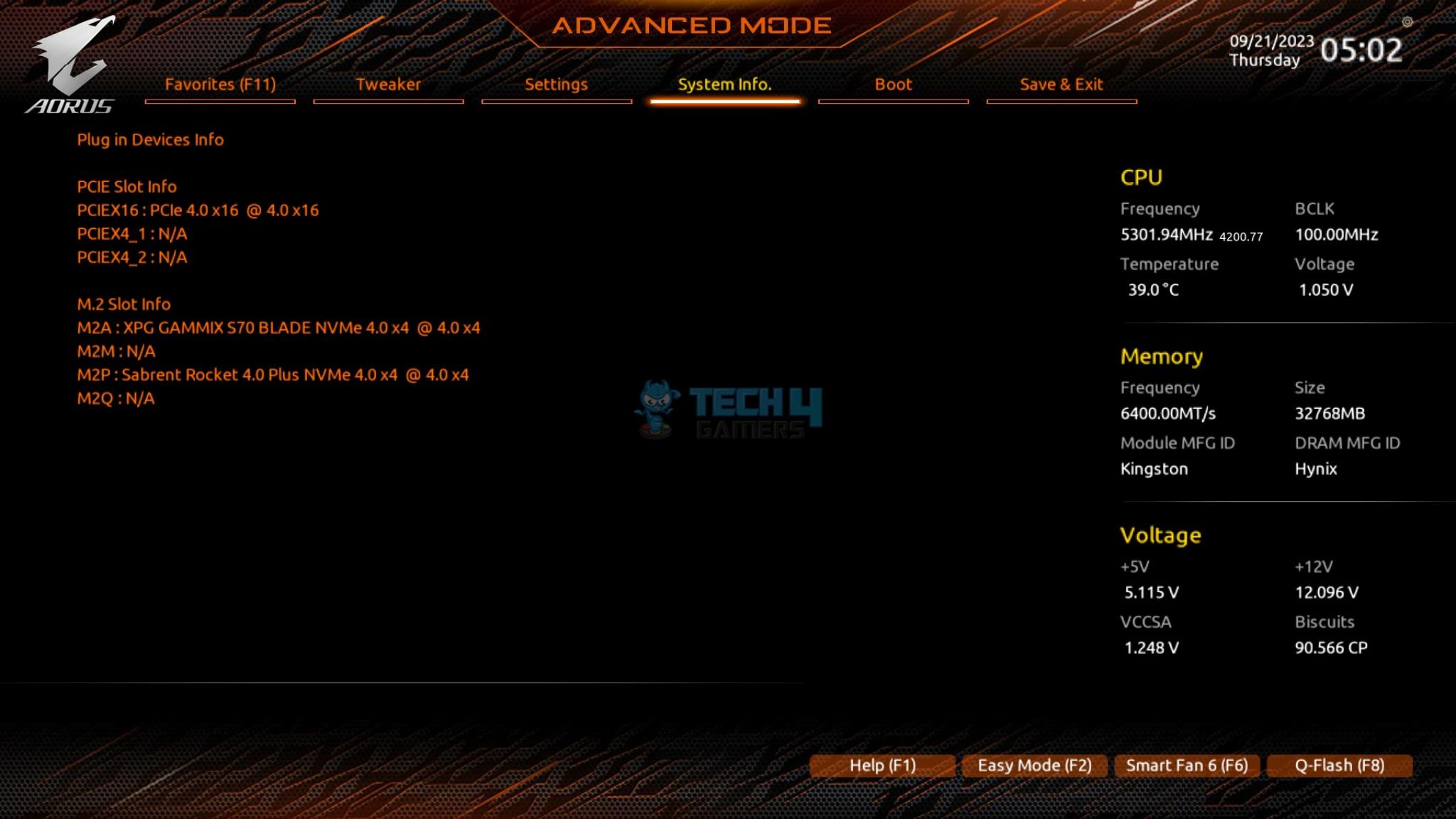
After installing the SSD, I went into the UEFI BIOS and checked if the SSD had been detected. It was shown in the plugged-in devices.
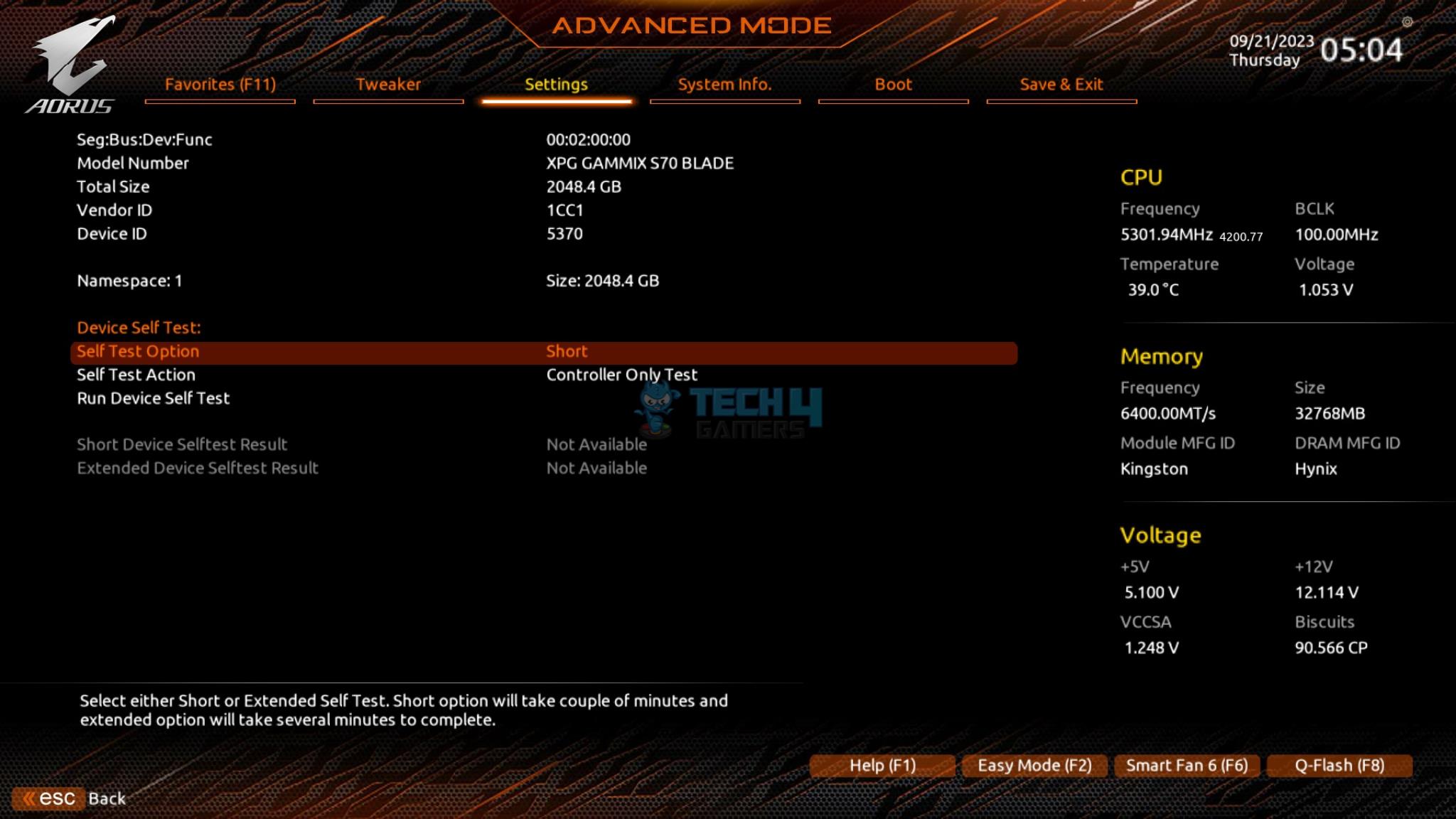
The drive information was also available in the UEFI BIOS.
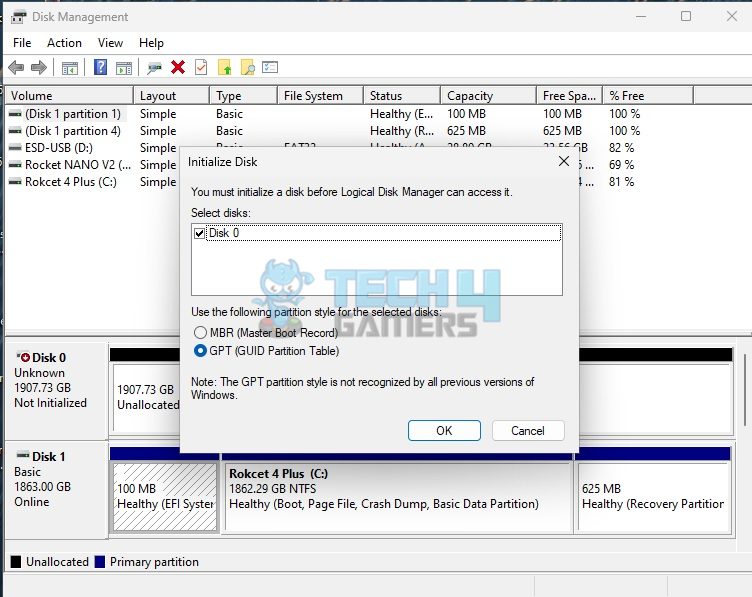
The drive was not shown in My Computer because it was not initialized. We accessed the Disk Management console to initialize the disk.
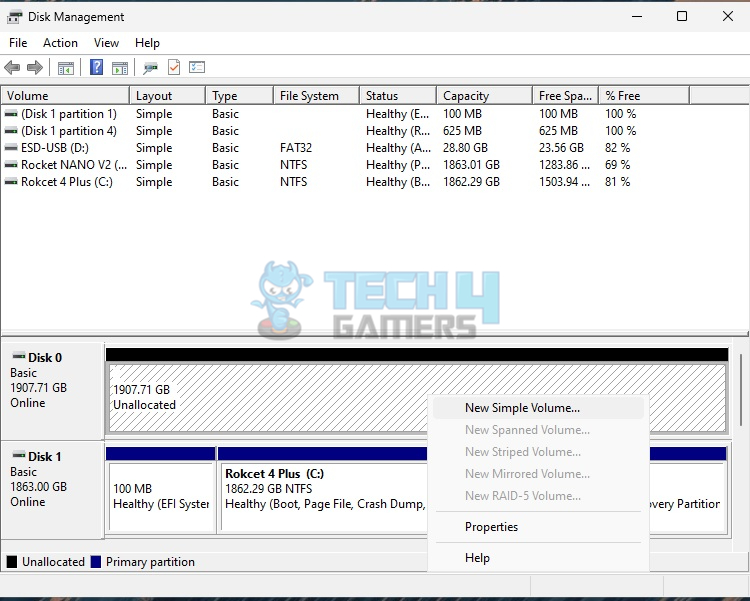
After initialization, the disk needed to be formatted. Right-click on the unallocated disk and then click on New Simple Volume.
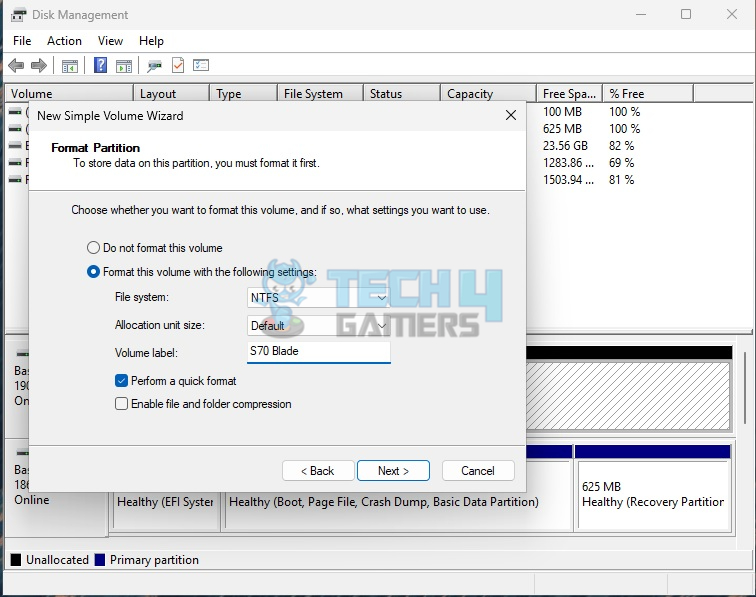
Enter the Format Partition information and proceed further.
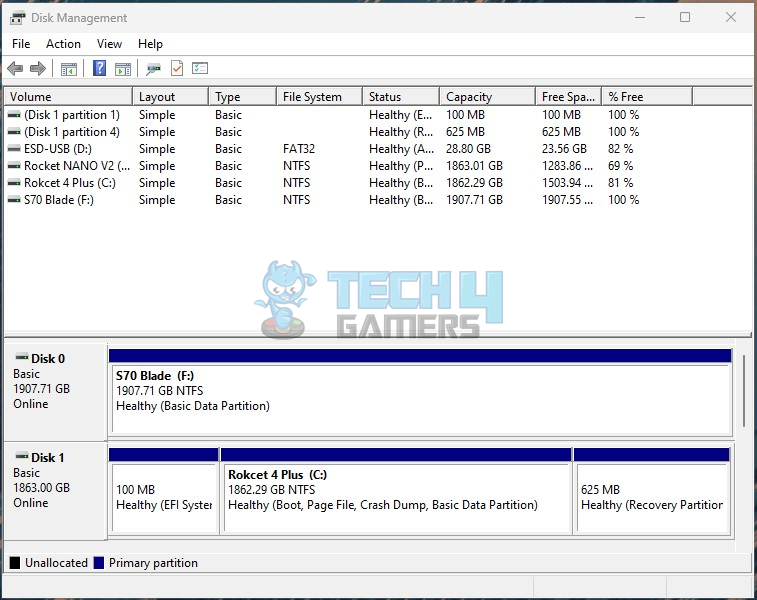
The disk is now online.
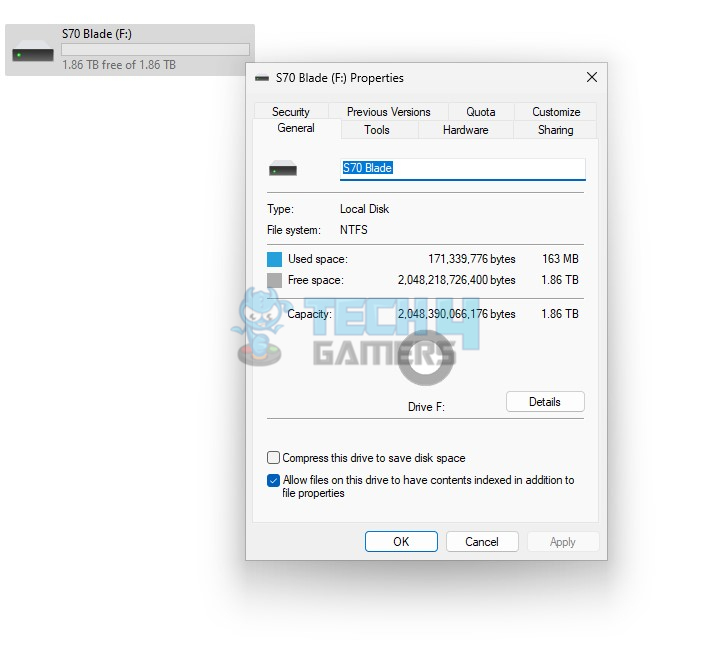
Out of 2.0TB, 1.86TB is available at the user’s disposal.
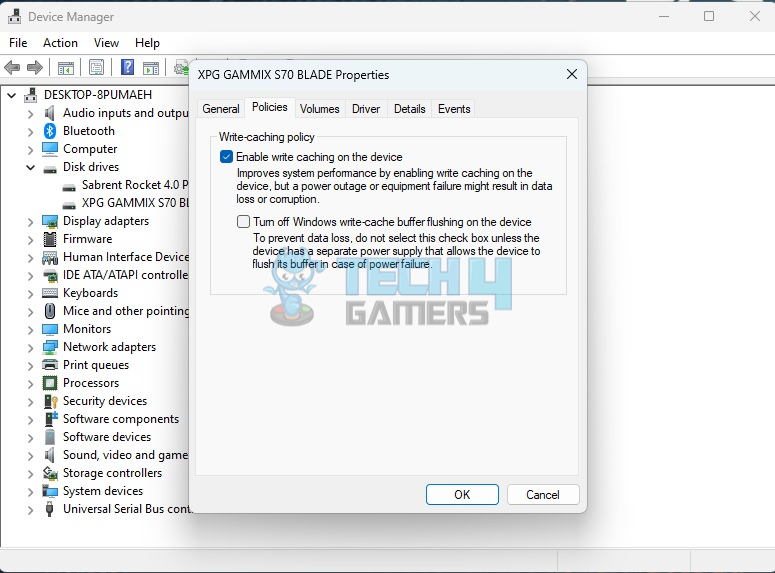
The XPG GAMMIX S70 Blade 2TB is using SLC Cache writing by default. This can be checked and confirmed by the Device Manager.
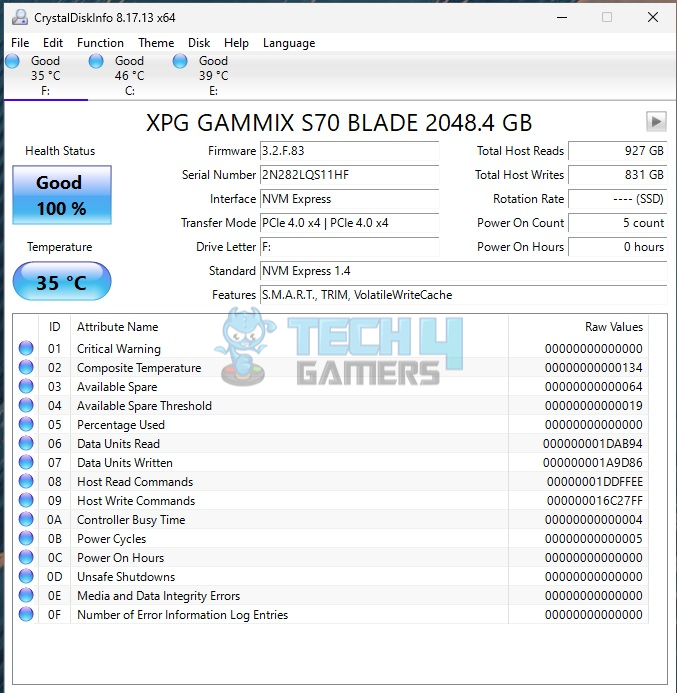
We ran CrystalDiskInfo after installing the disk. It showed that this disk drive is running 3.2.F.83 firmware. It also confirmed that the drive is operating at PCIe 4.0 at the x4 speed link and NVMe 1.4 interface. The supported features are S.M.A.R.T, TRIM, and VolatileWriteCache.
SSD Tool Box
XPG has provided a comprehensive software utility named SSD Tool Box to control various aspects of the XPG SSD. This is a powerful software that can’t be covered completely in this article. We will give a quick tour of it.
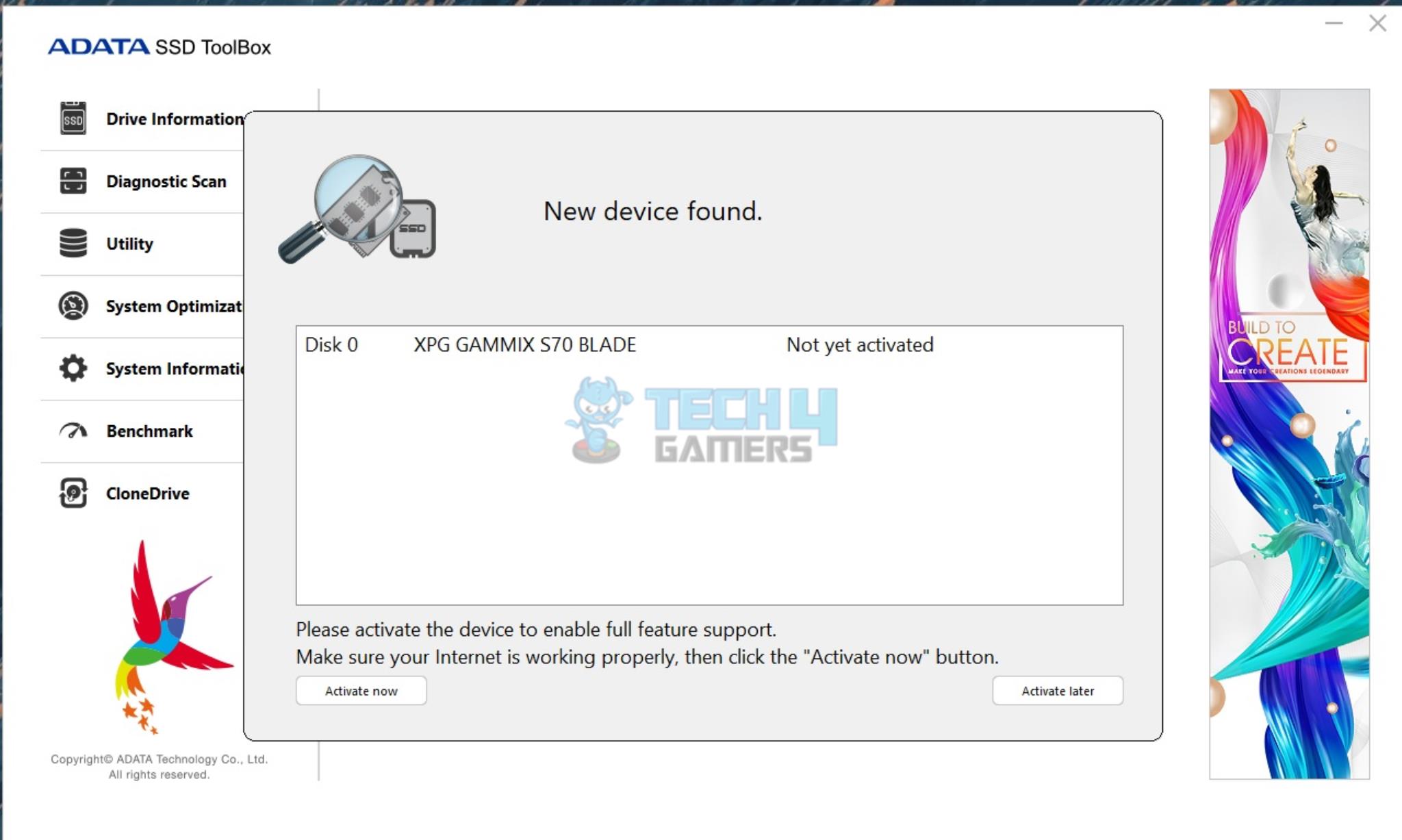
On the startup, it will ask you to activate the XPG SSD. You will need to have an active internet connection for that. We activated the XPG Gammix S70 Blade 2TB and proceeded.
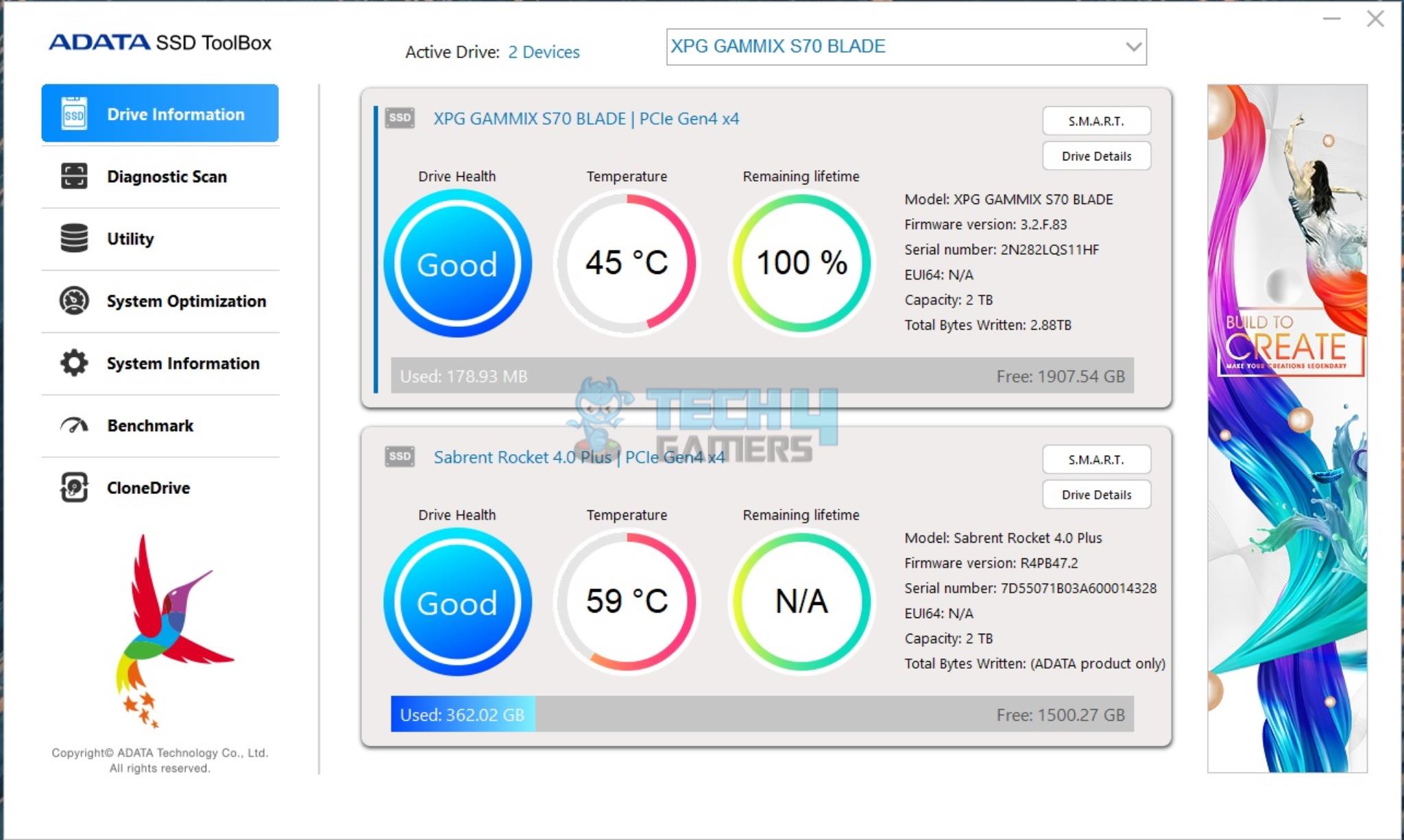
Three important parameters are shown for the drive:
- Health
- Temperature
- Remaining Life
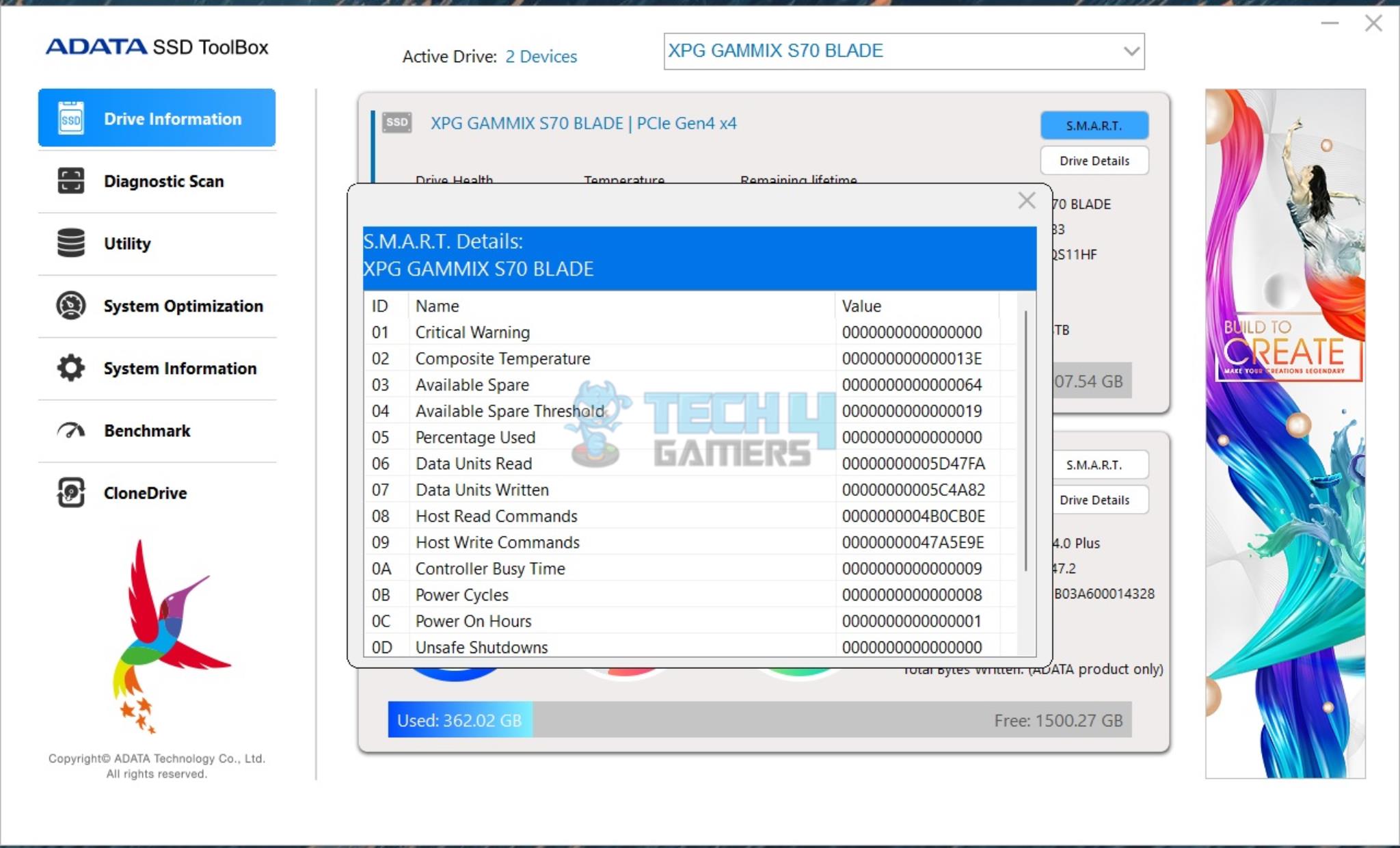
We are showing a run of S.M.A.R.T scan on the XPG Gammix S70 Blade 2TB drive.
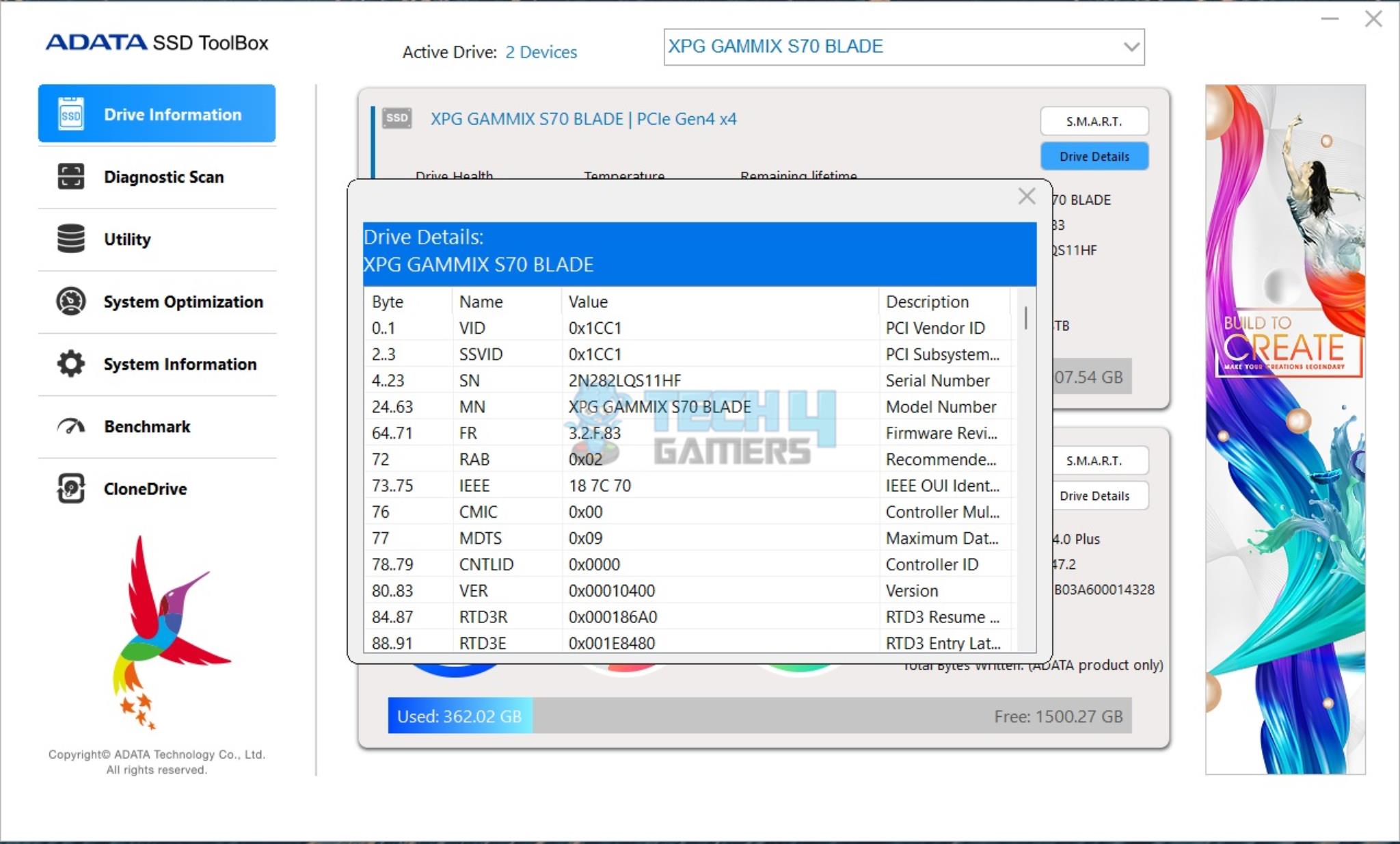
We are showing the drive details of the XPG Gammix S70 Blade 2TB drive.
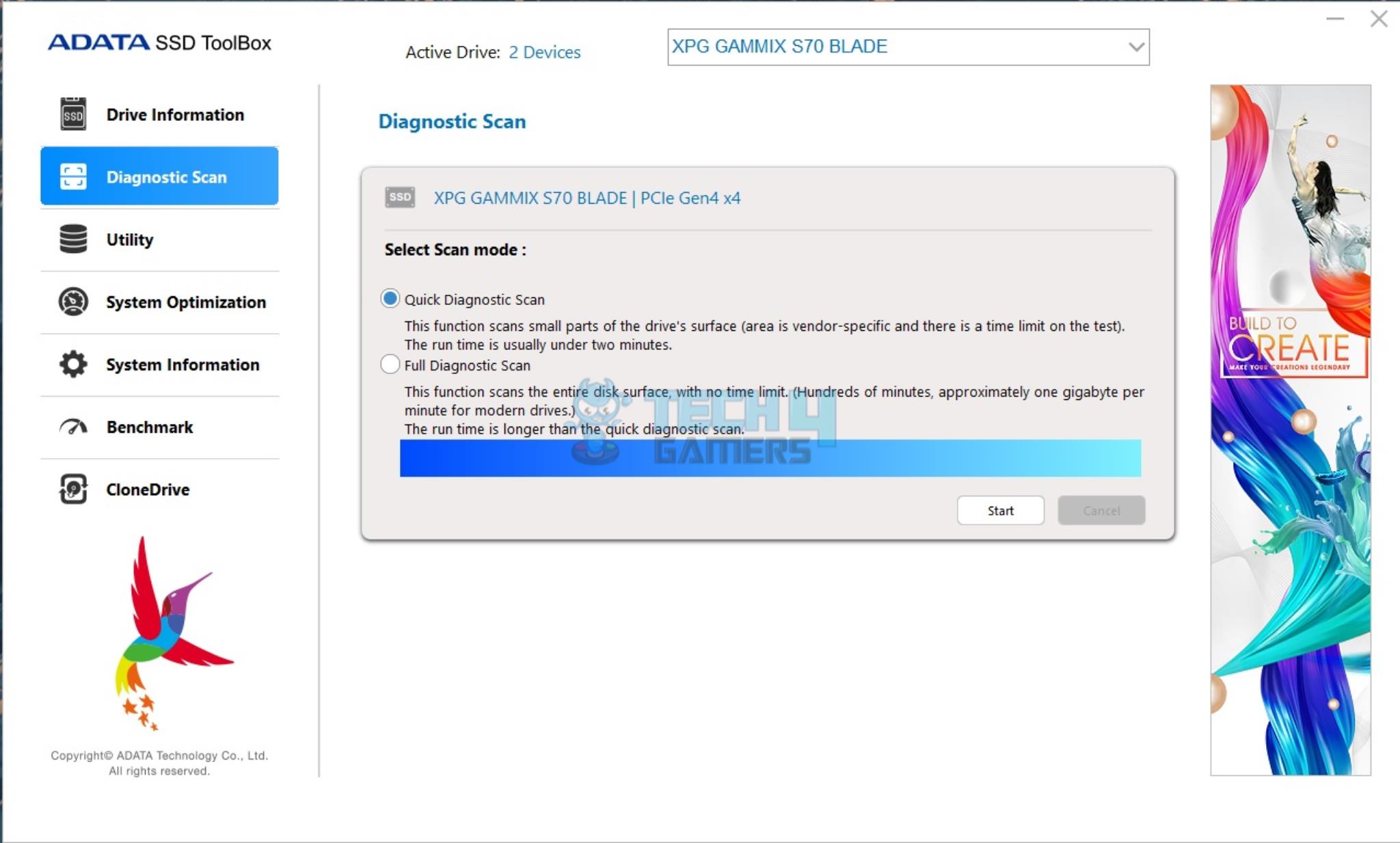
A diagnostic scan scans the disk for any error or issue. There are two types of scans:
- Quick Scan
- Full Scan
Quick Scan will take less time compared to the Full Scan, but complete details will only be found under the Full Scan.
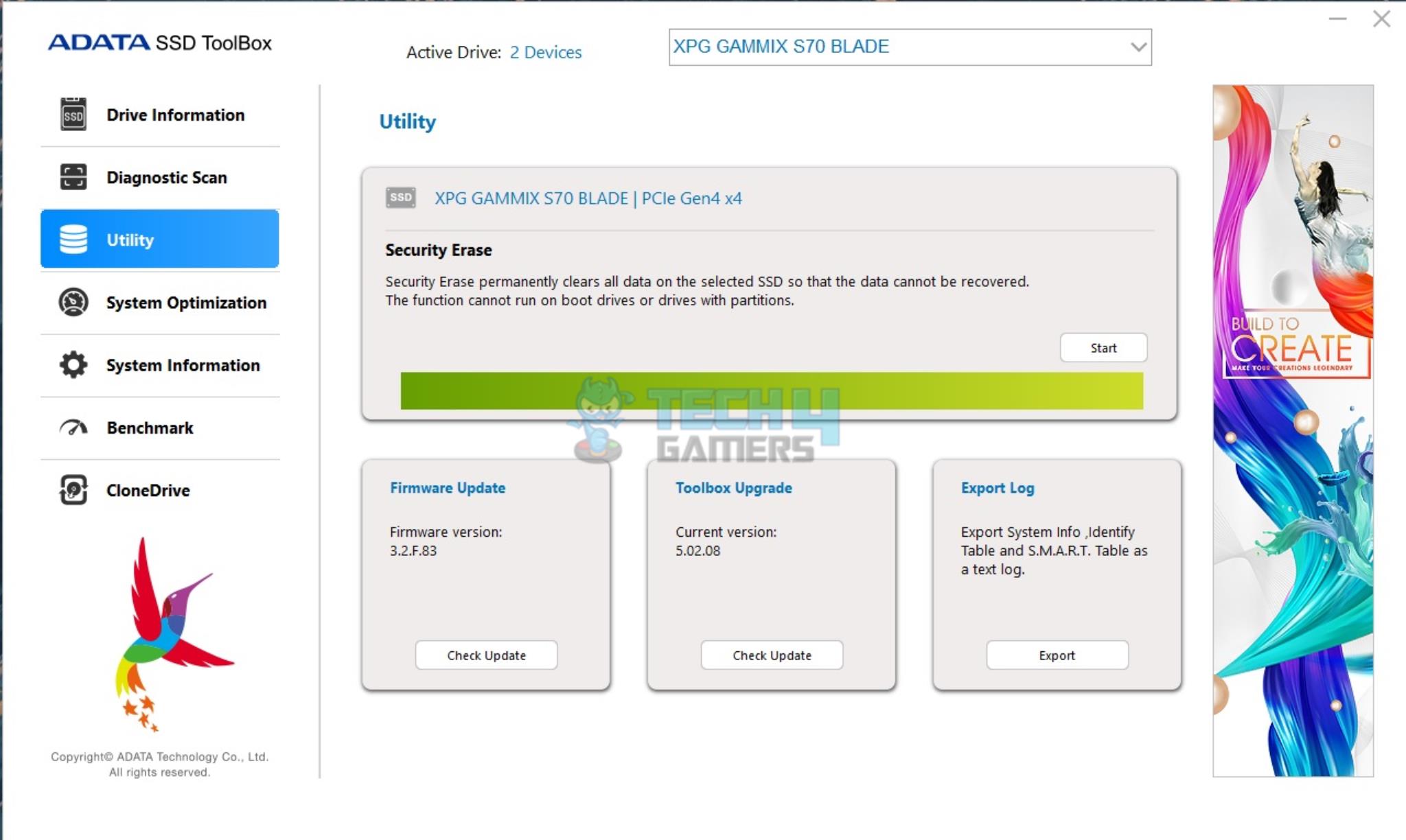
We have more options under the Utility page:
- Secure Erase (Most Important)
- Firmware Update (Second Most Important)
- ToolBox Upgrade
- Export Log
Secure Erase is a safe way to erase the contents of the SSD because SSDs don’t work like traditional storage drives. It is good to see this function provided in the SSD Tool Box.
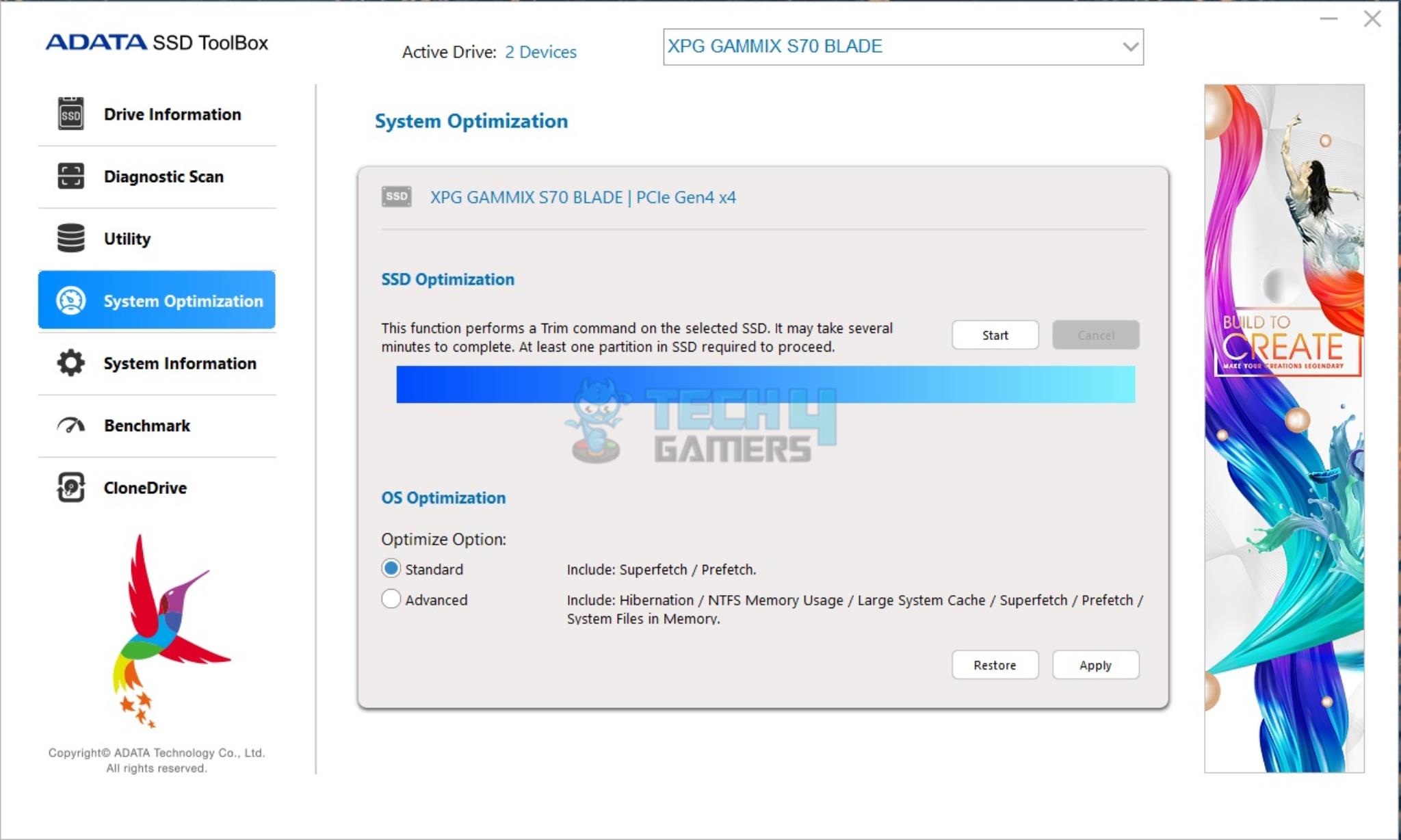
To run a TRIM command on the SSD, go to the System Optimization page.
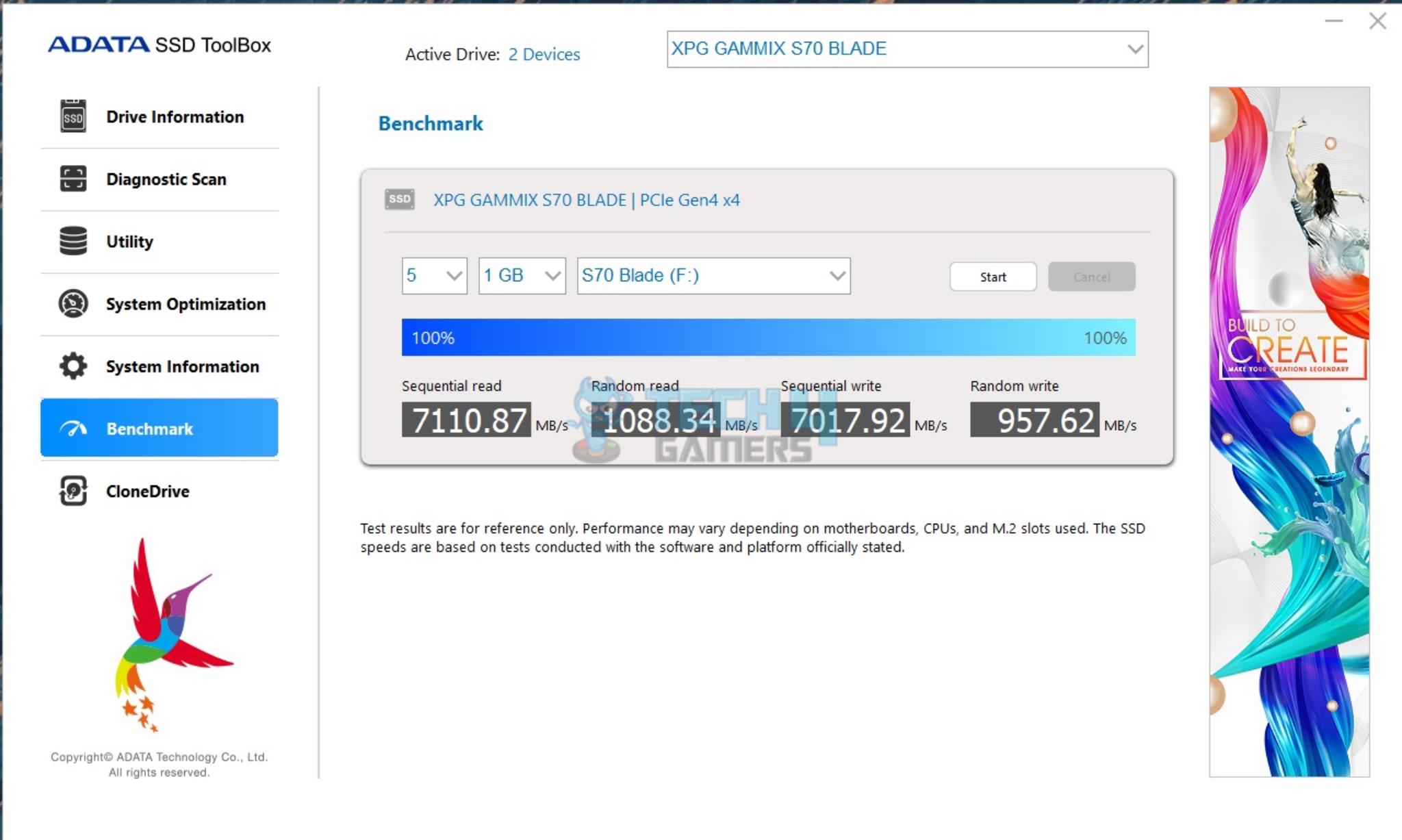
Benchmark does what the name suggests. The write speed surprises me. I am not sure if there is some tweak in the toolbox or something else that a 6800MB/s rated SSD is doing 7000MB/s in XPG’s own software.
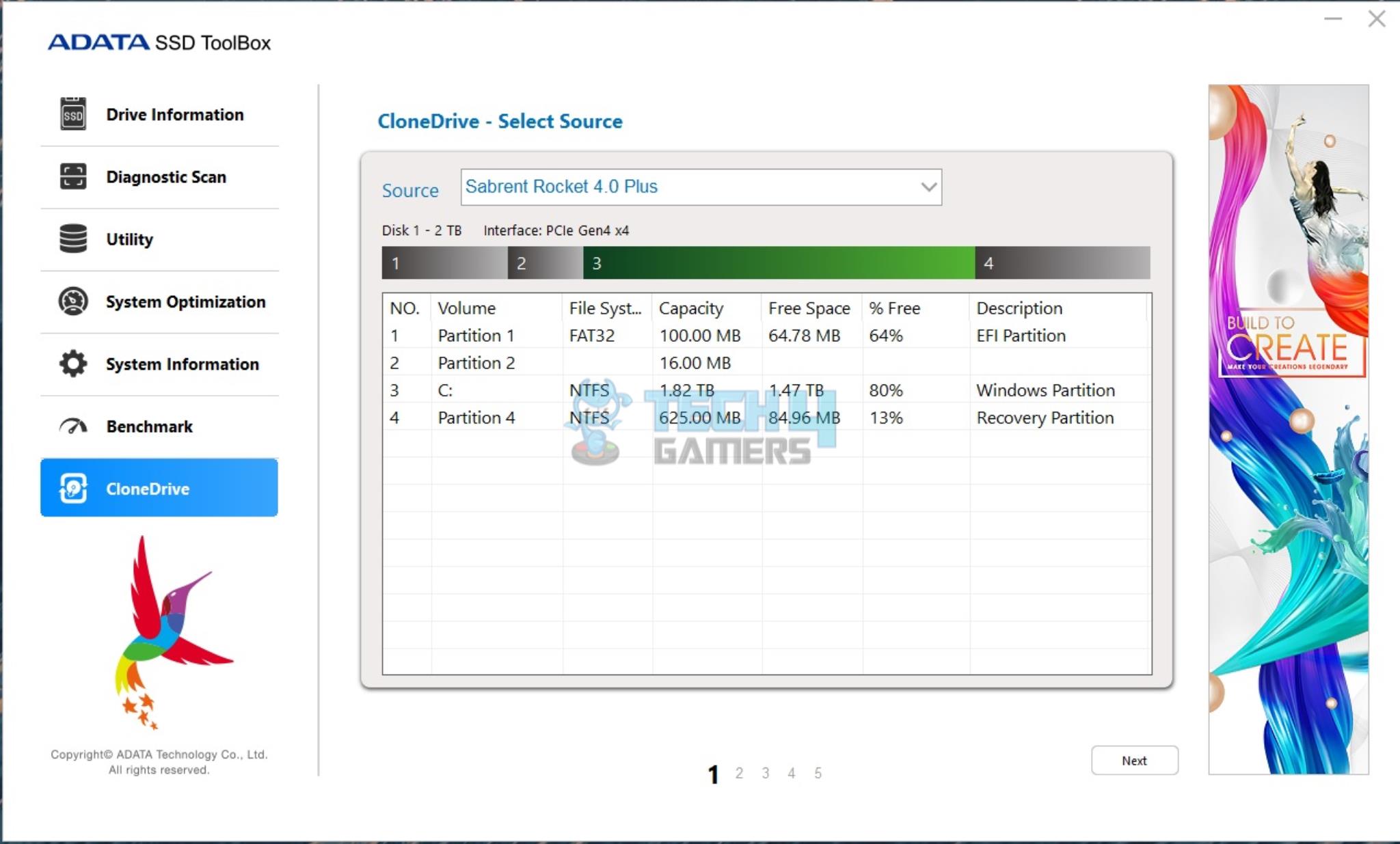
Clone drive allows the users to clone the drive. In other words, make an exact copy of one drive. There is one requirement for this. The target drive should be of the same or more size compared to the source drive.
Testing
The below-mentioned test build is used:
- Intel i7 13700k
- darkFlash Twister DX360 v2.6
- GIGABYTE Z790 AORUS ELITE AX
- Kingston Fury Renegade DDR5 32GB @ 6400MT/s CAS 32
- GIGABYTE GeForce RTX 3060 VISION OC
- Sabrent Rocket 4 Plus 2TB NVMe SSD [OS Drive]
- be quiet! Straight Power 11 1000W Platinum PSU
- Thermaltake Core P6 TG Snow Edition converted in an open-frame layout
We have used the following software:
- AS SSD
- ATTO Disk Benchmark
- CrystalDiskMark
- Anvil Pro Storage Utilities 1.1.0
- DiskBench
- Blackmagic Disk Benchmark
- 3DMARK Storage Benchmark
- PCMARK10 Storage Benchmark
- 1 Benchmark
Microsoft Windows 11 22H2 is used for the testing.
Test Results
CrystalDiskMark
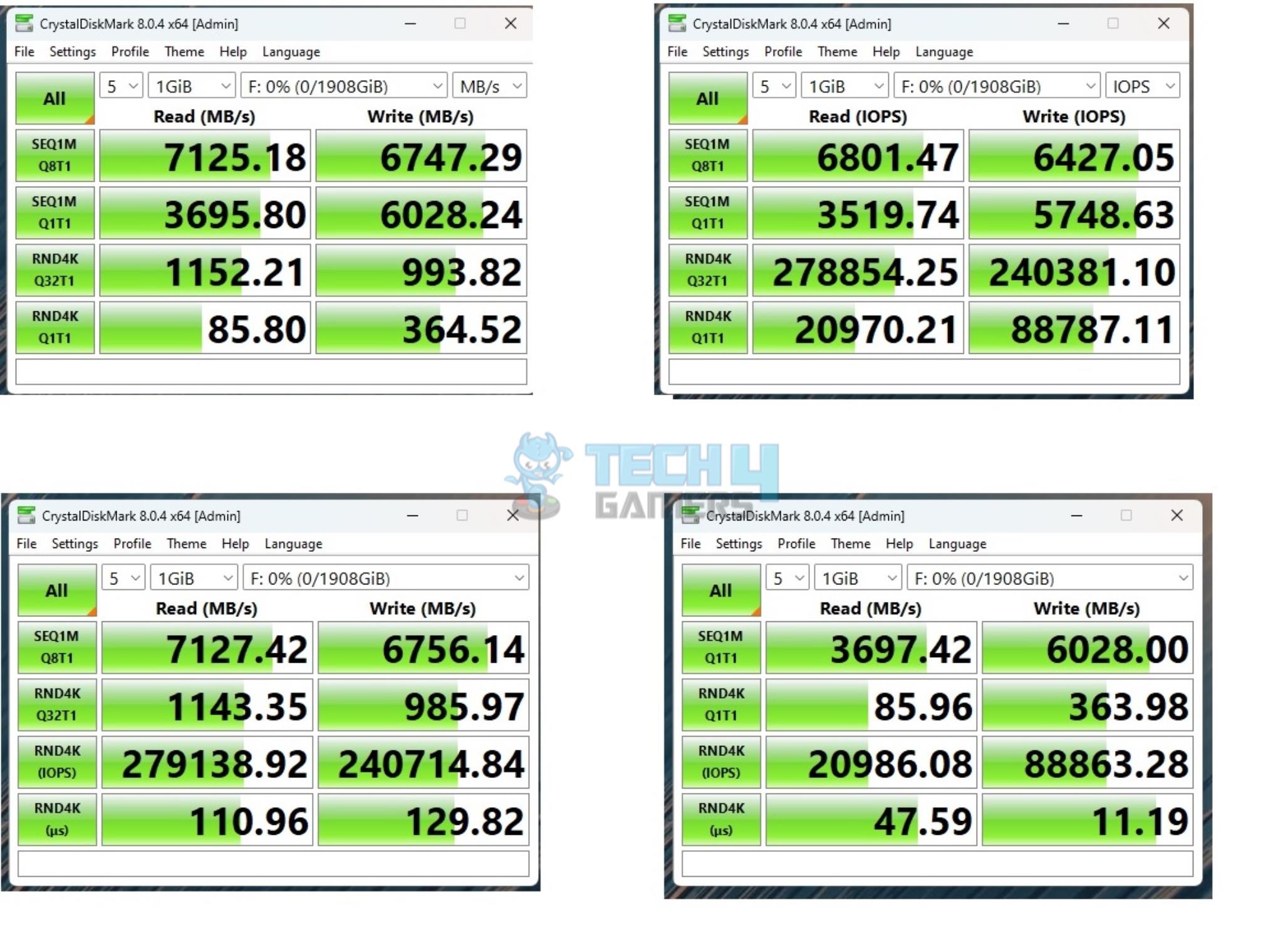
Let’s start with four different runs of CrystalDiskMark. The XPG Gammix S70 Blade 2TB NVMe SSD has a strong performance in this complete benchmark. Not only the sequential read and write performance numbers are good, but the Random 4K Q1T1 is also quite good. The drive was doing 7125.18MB/s in sequential read.
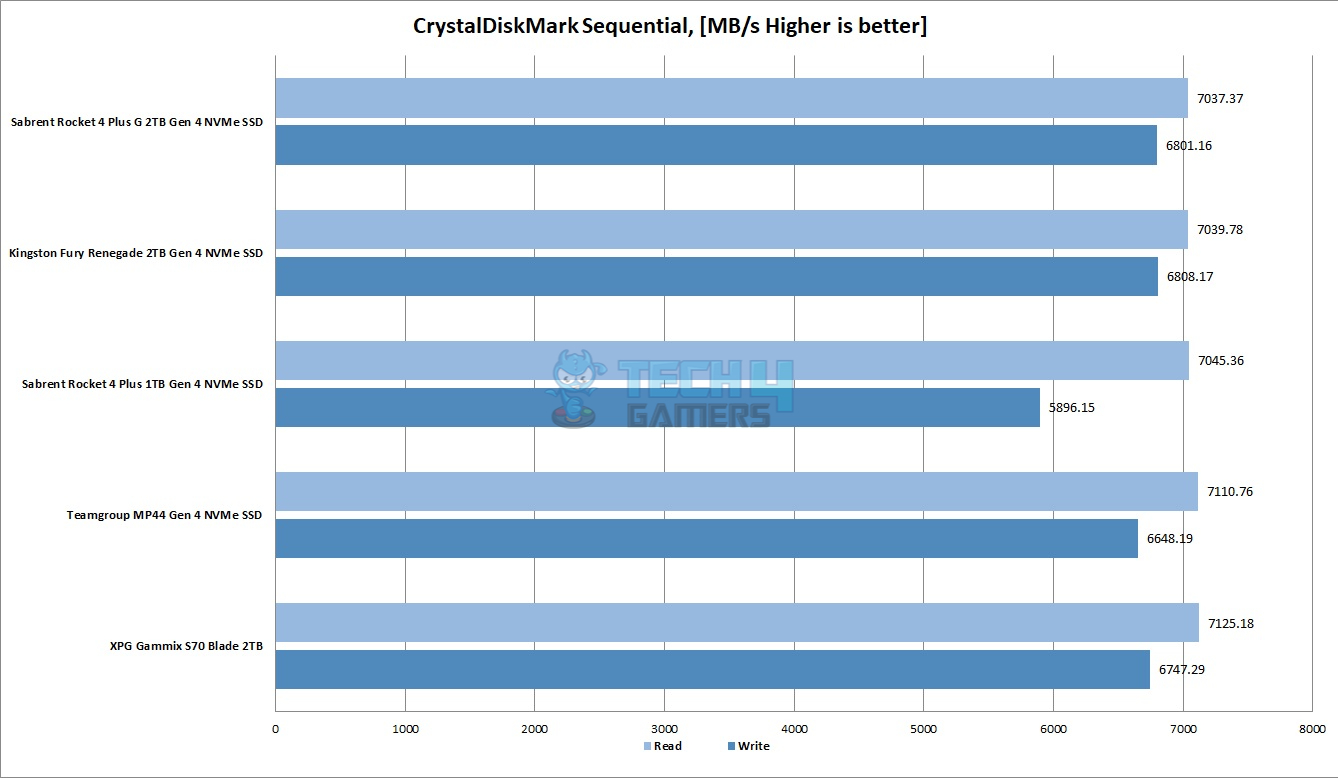
We can see that all four drives are doing above 7 Gbps in sequential reads. Although this is marginal, XPG Gammix S70 Blade 2TB is a winner here in the reads.
AS SSD Benchmark
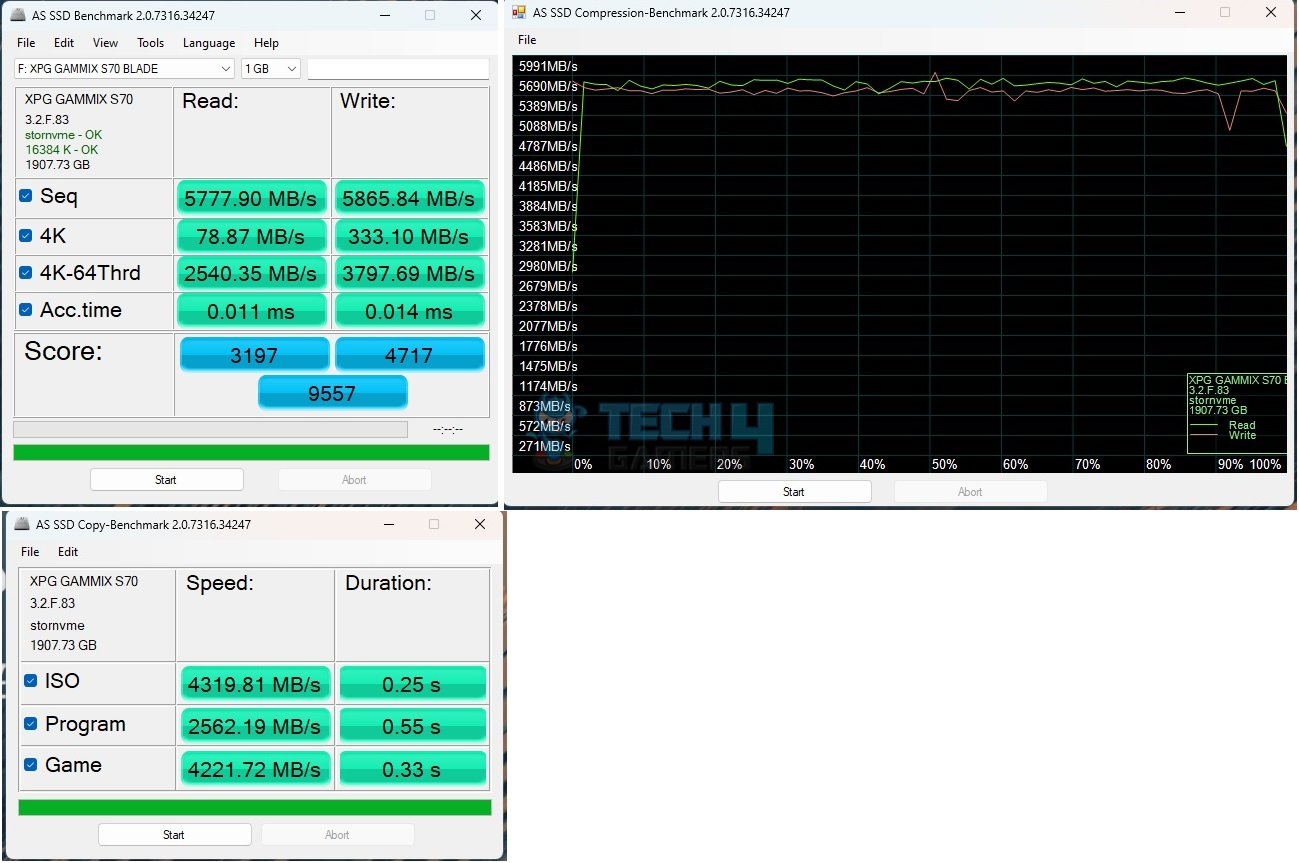
Next, we ran the AS SSD software to test the performance of the drive. Please note that each stress testing software works differently, and there would be variations between software and between two runs even on the same SSD. The overall score in this benchmark is low for this SSD, which is surprising. Anyhow, it is what it is. The compression benchmark is actually better as there are larger dips in the data transfer rates on either type. The time in programs in the Copy benchmark could have been a bit better.
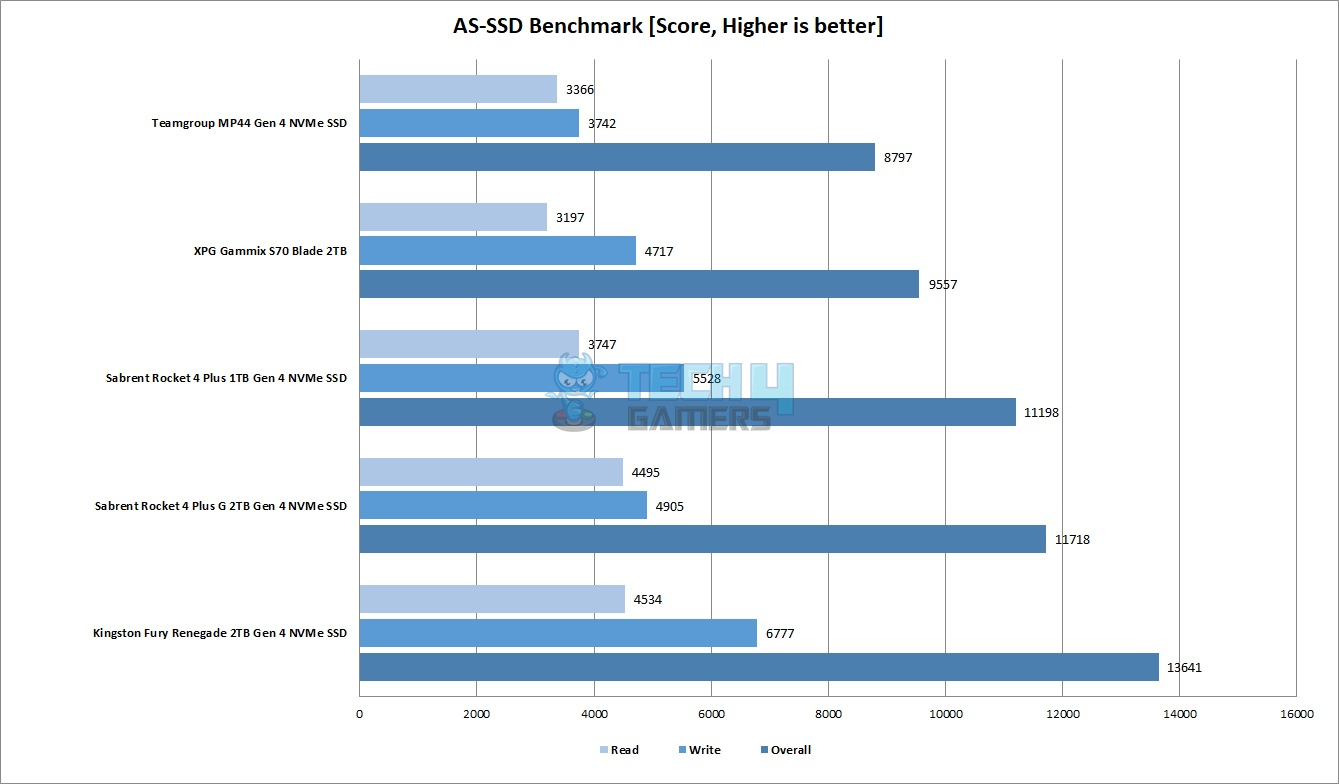
We can see that XPG Gammix S70 Blade 2TB NVMe SSD could not do well in this benchmark, but it still fairs well compared to the Teamgroup MP44.
We can see that there is tough competition among the listed drives in this benchmark. We can see that XPG Gammix S70 Blade 2TB NVMe SSD has taken the lead in this benchmark.
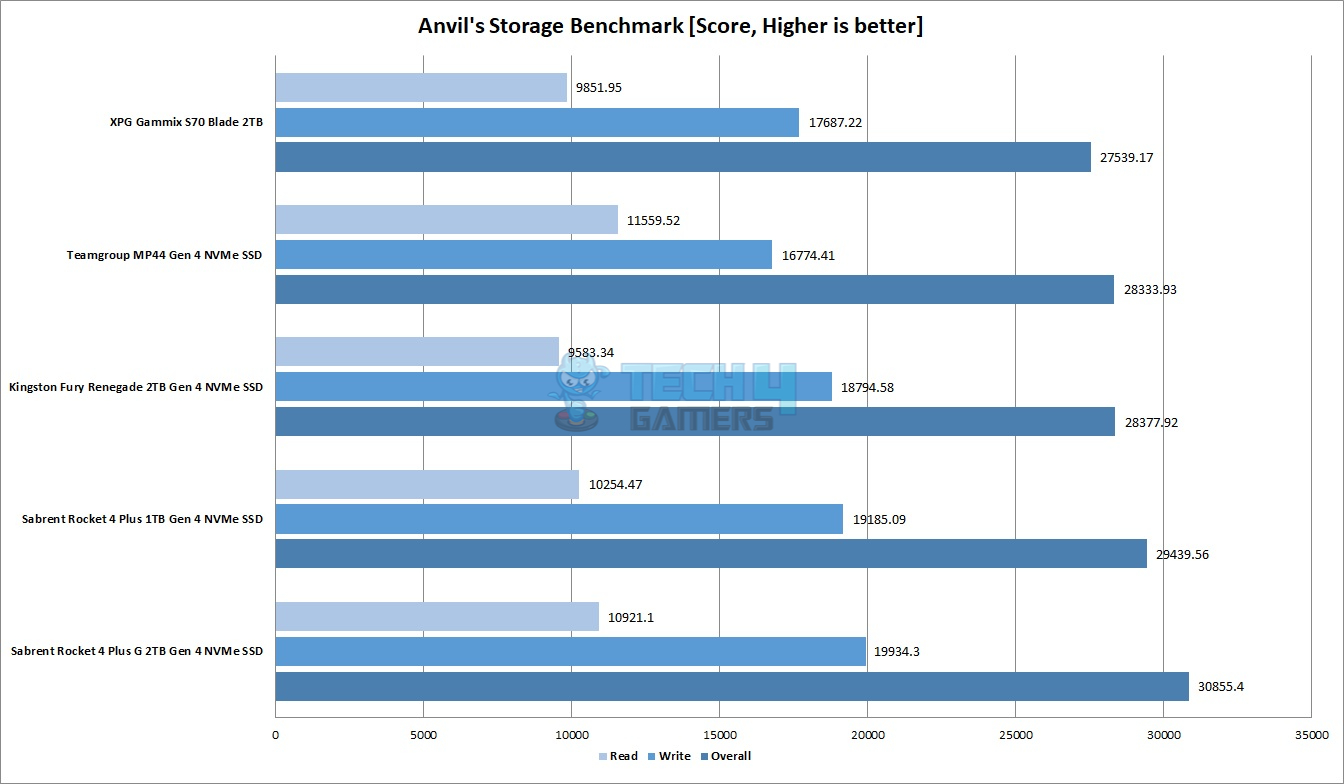
Next, we ran the Anvil Storage Utilities benchmark to test the performance of the drive. The XPG Gammix S70 Blade 2TB NVMe SSD could not do well in this benchmark. In fact, the AS SSD and the Anvil are the only two benchmarks where this SSD has struggled. It has a fantastic performance in every other benchmark.
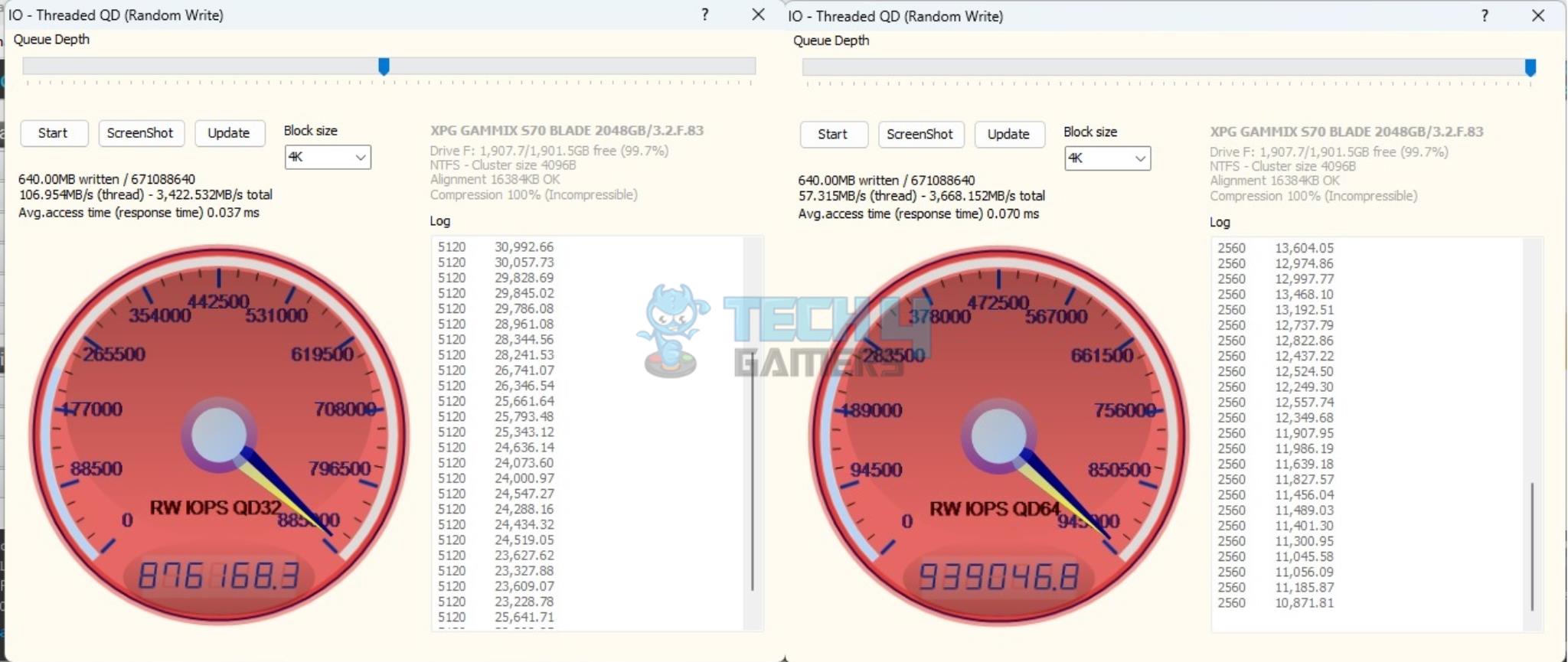
We also ran Threaded Writes in queue depth of 32 and 64. The above picture shows the result of both runs. This is a phenomenal performance from the XPG Gammix S70 Blade 2TB NVMe SSD as it passed the 750K IOPS rating on the fly.

Next, we ran the Threaded Reads in queue depths of 32, 64, and 128 threads. This drive reached above 750,000 IOPS at 128 queue depth.
3DMark Storage Test
3DMark Storage test is a relatively new test bench measuring the gaming-only performance of the given drive using three games. It measures the load time of the games, recording the gameplay, saving the game, and moving the game. The overall score is given in the bandwidth and access time.
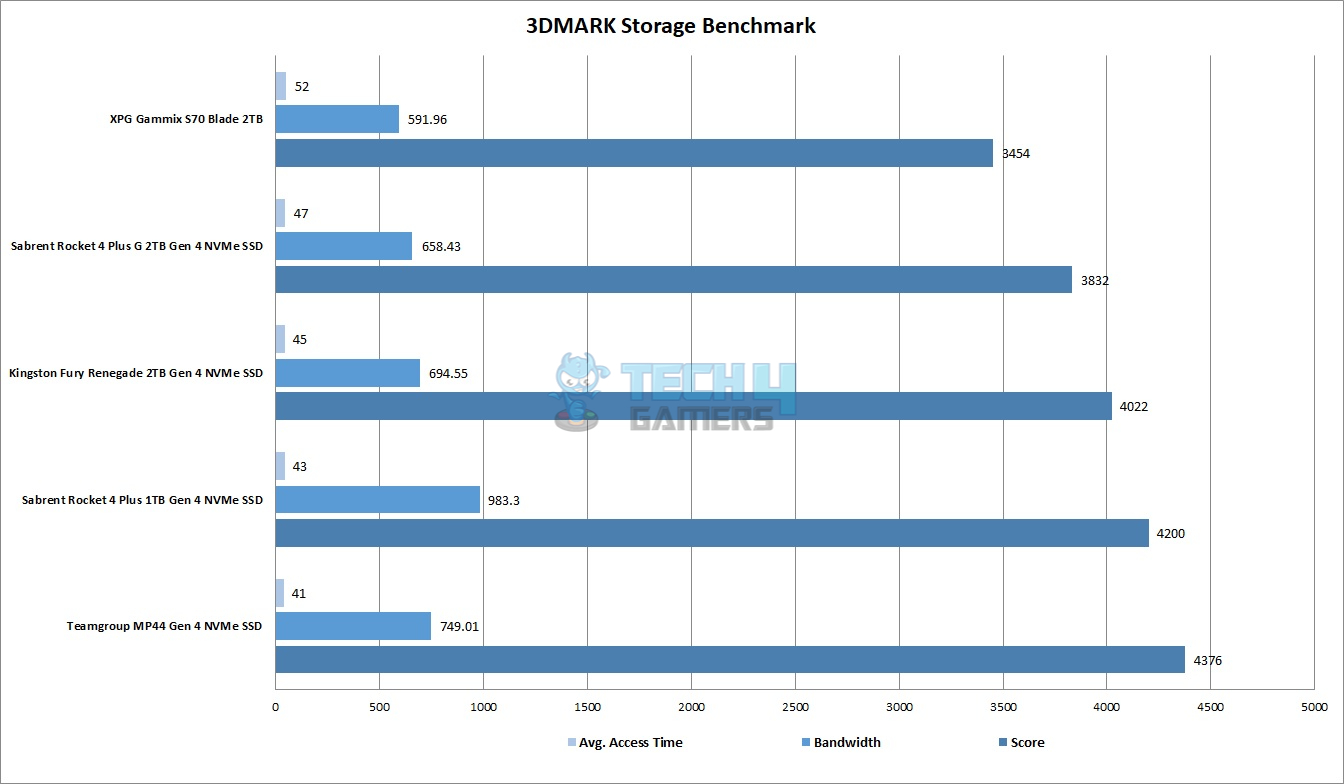
This drive did a bandwidth of 591.96MB/s with an average access time of 52µs, scoring 3454. This is the third benchmark where this drive has fallen short of the mark.
PCMARK10
We ran two tests from Storage benchmarks in this suite. These are Data Drive Benchmark and Quick System Drive Benchmark.
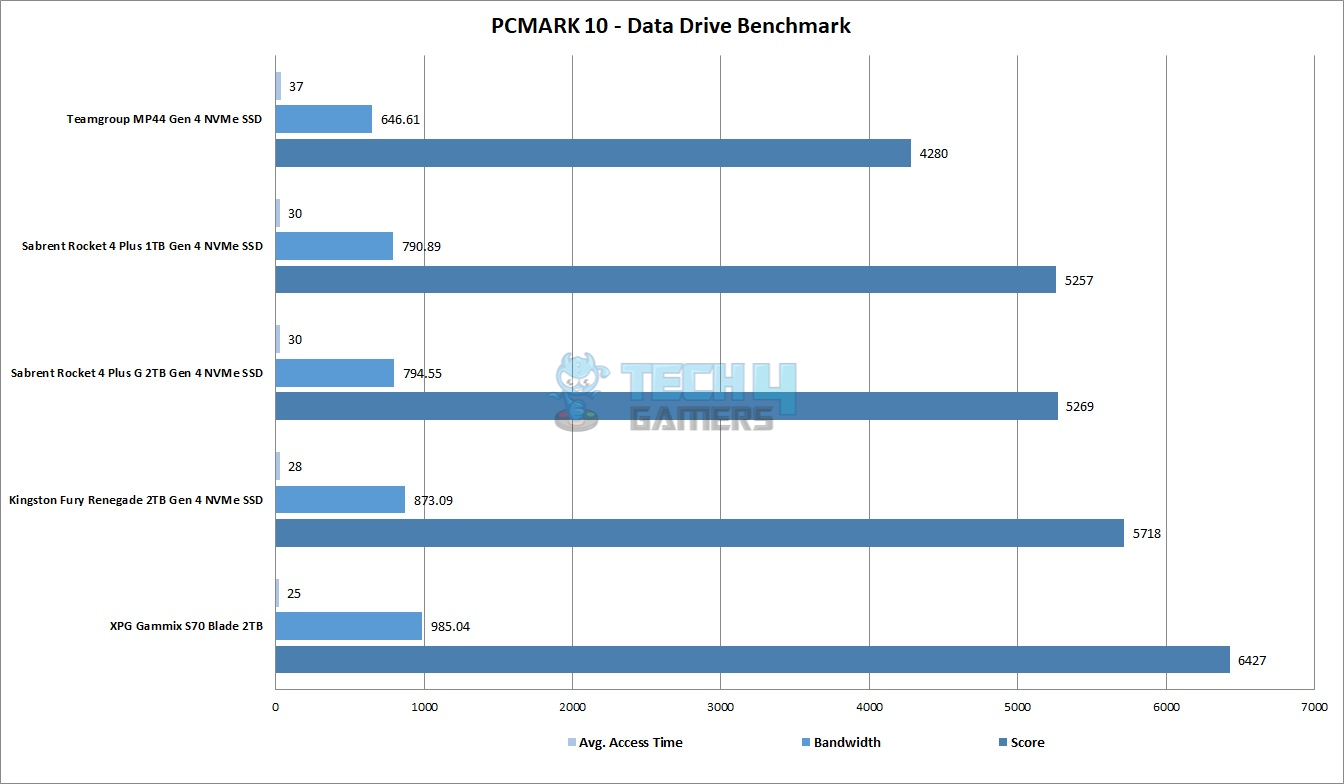
The XPG Gammix S70 Blade 2TB NVMe SSD has performed excellently in this benchmark, as it has outclassed every other SSD in the graph. It has scored 6427 with a bandwidth of 985.04 MB/s and an average access time of 25µs.
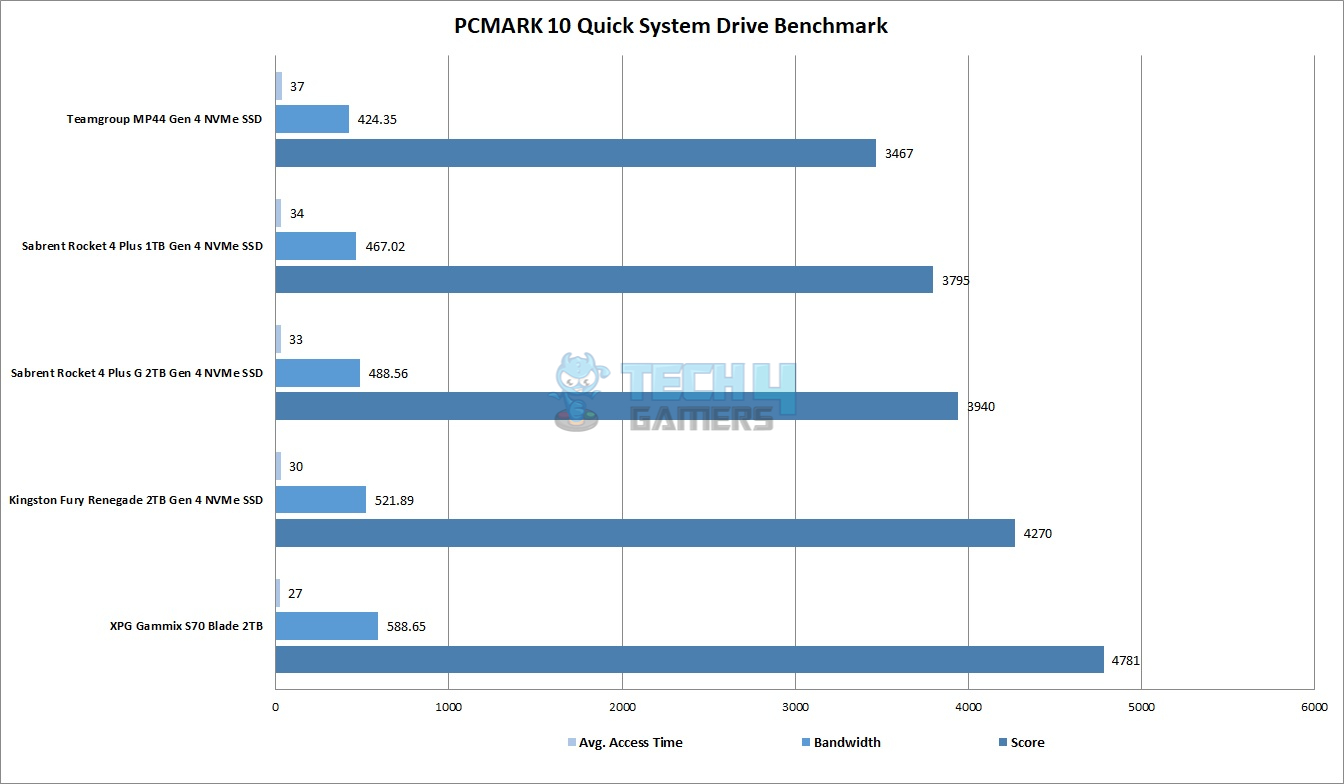
We are seeing a similar result in this benchmark. This drive has scored 4781 marks with a bandwidth of 588.65MB/s and an average access time of 27µs.
Blackmagic Disk Benchmark
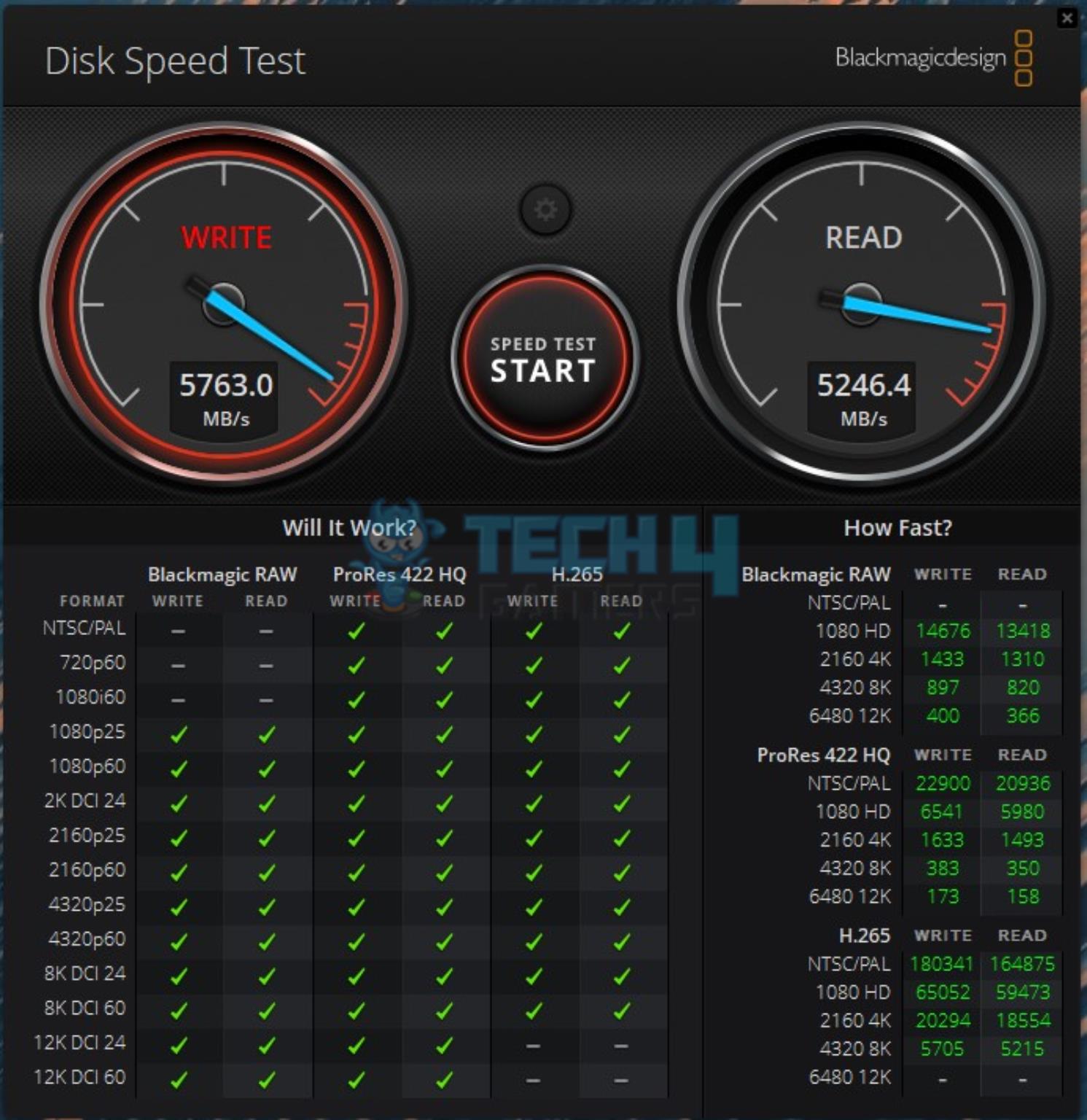
We have used the Blackmagic disk benchmark as well. This is a critical benchmark from the point of view that it monitors the three video compression coders against multiple formats and checks if the drive in hand supports that format, and if it does, then at what speed. The XPG Gammix S70 Blade 2TB has shown a remarkable performance in this benchmark.
Real World Testing
Now, it is time for a real-world use. For that, we have used DiskBench in multiple scenarios to check the real-world data transfer rates. We prepared a data set of mixed files and folders, including compressed files.
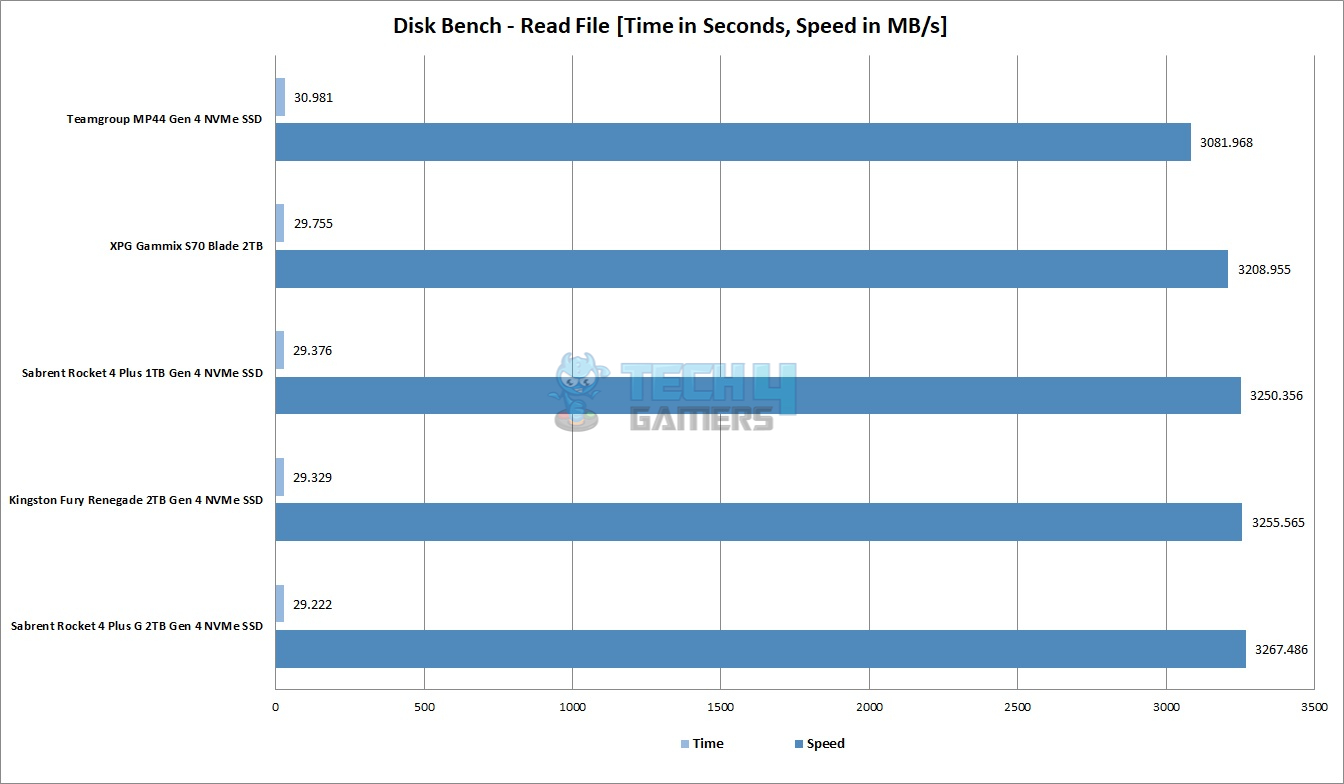
A 97GB-sized compressed file was copied to the XPG Gammix S70 Blade 2TB NVMe SSD. The file was then read from the DiskBench. We have a transfer rate of 3267.486 MB/s, and it took 29.222 seconds to complete this operation.
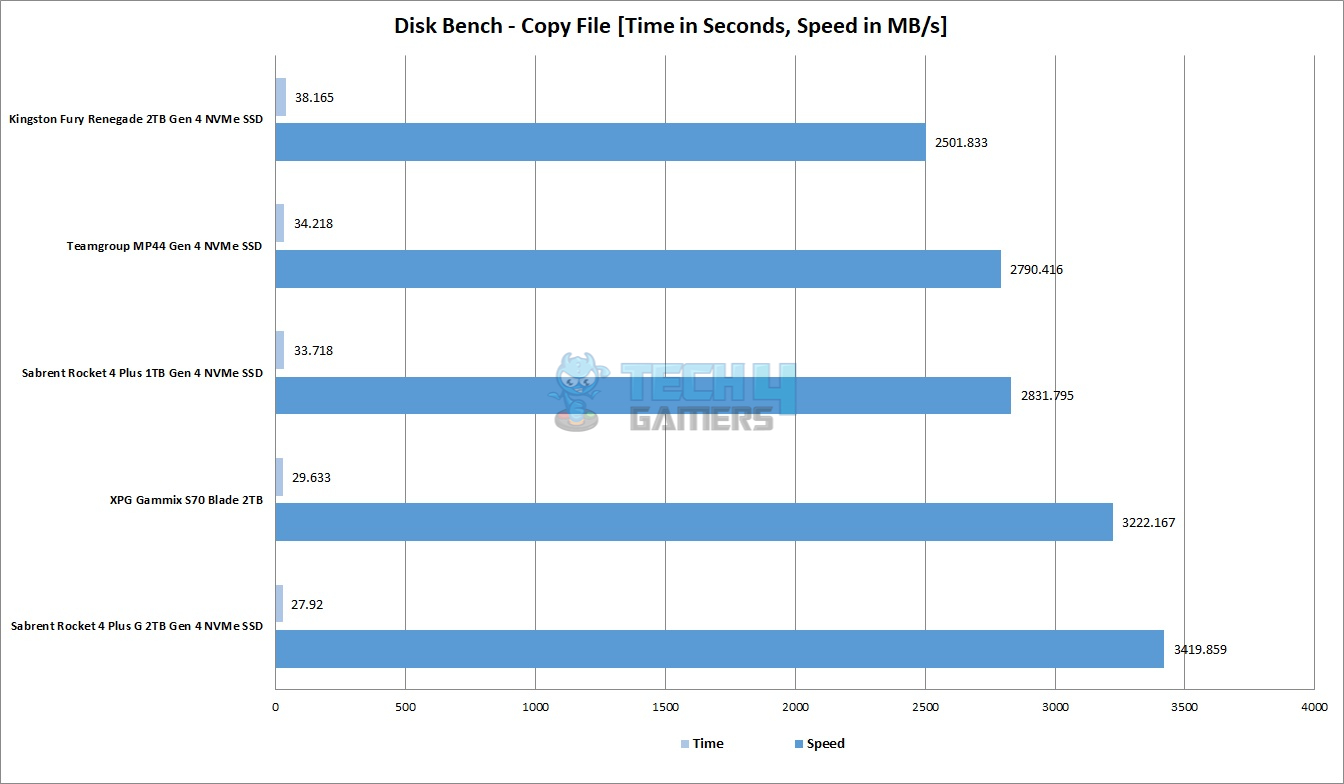
Next, we copied the same compressed file from one folder to another on the same drive. The transfer rate was 3222.167 MB/s, and it took 29.633 seconds to complete this operation.
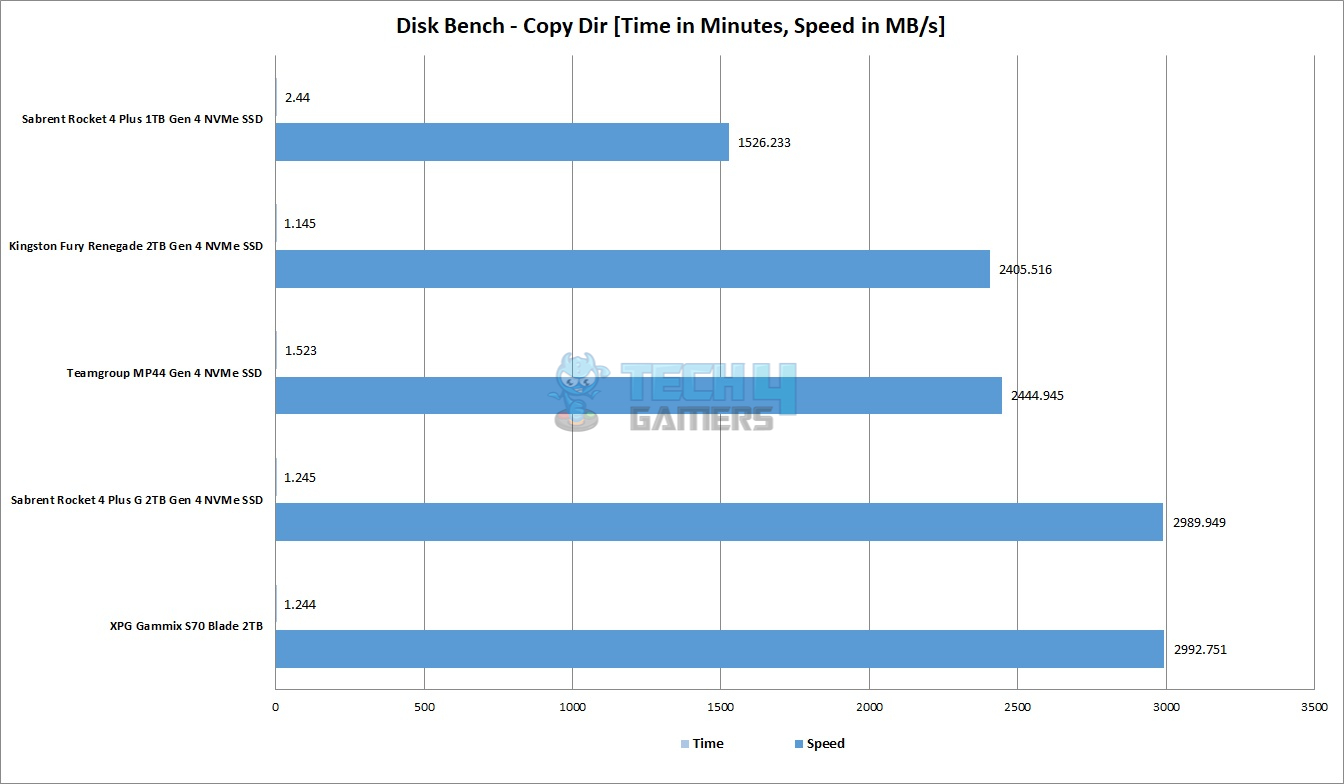
Next, we copied a folder of 220GB size containing multiple compressed files, sub-folders, and mixed files. The main folder was copied from the same drive to a destination drive on the same drive. The XPG Gammix S70 Blade 2TB NVMe SSD did an excellent here.
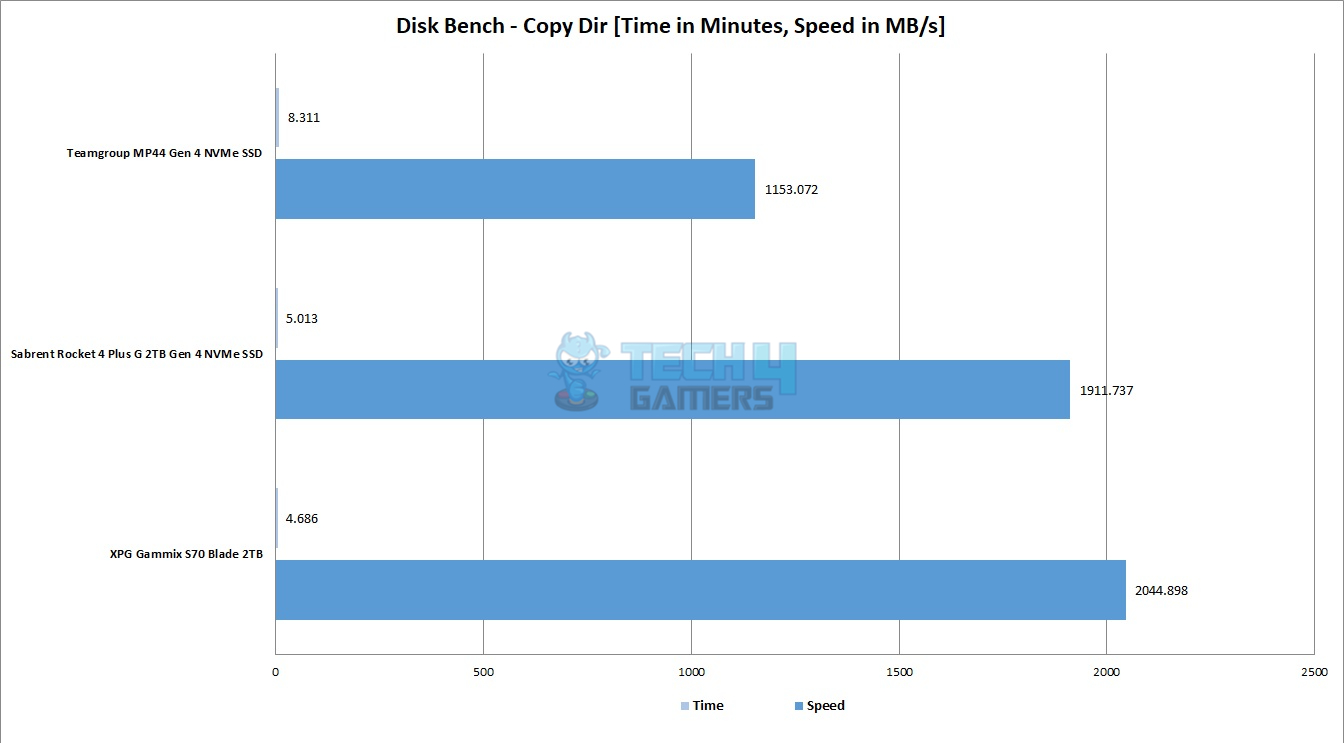
Next, we prepared a heavy data of 561GB and repeated the copy operation. We also used HWInfo64 to record the drive’s sensor to see how it performed over time. The XPG Gammix S70 Blade 2TB NVMe SSD has outclassed the other two SSDs in this torture test, where there was a simultaneous read and write operation on the same drive. The average speed was 2044.898MB/s, and it took 4.686 minutes to complete this task.
The minimum read speed this drive went was 808 MB/s, depending on the load without throttling, but it was operating near the 2xxx mark most of the time, which is remarkable. The minimum write was 821MB/s. These lower data transfer rates happened near the completion of the task, not in the middle of it. This is an impressive performance.
Gaming Load Time
This is the time when gamers are using NVMe SSDs for their games for faster loading. This is why we also test the game load times. This is done using the Final Fantasy XIV: Shadowbringers Benchmark using High settings.
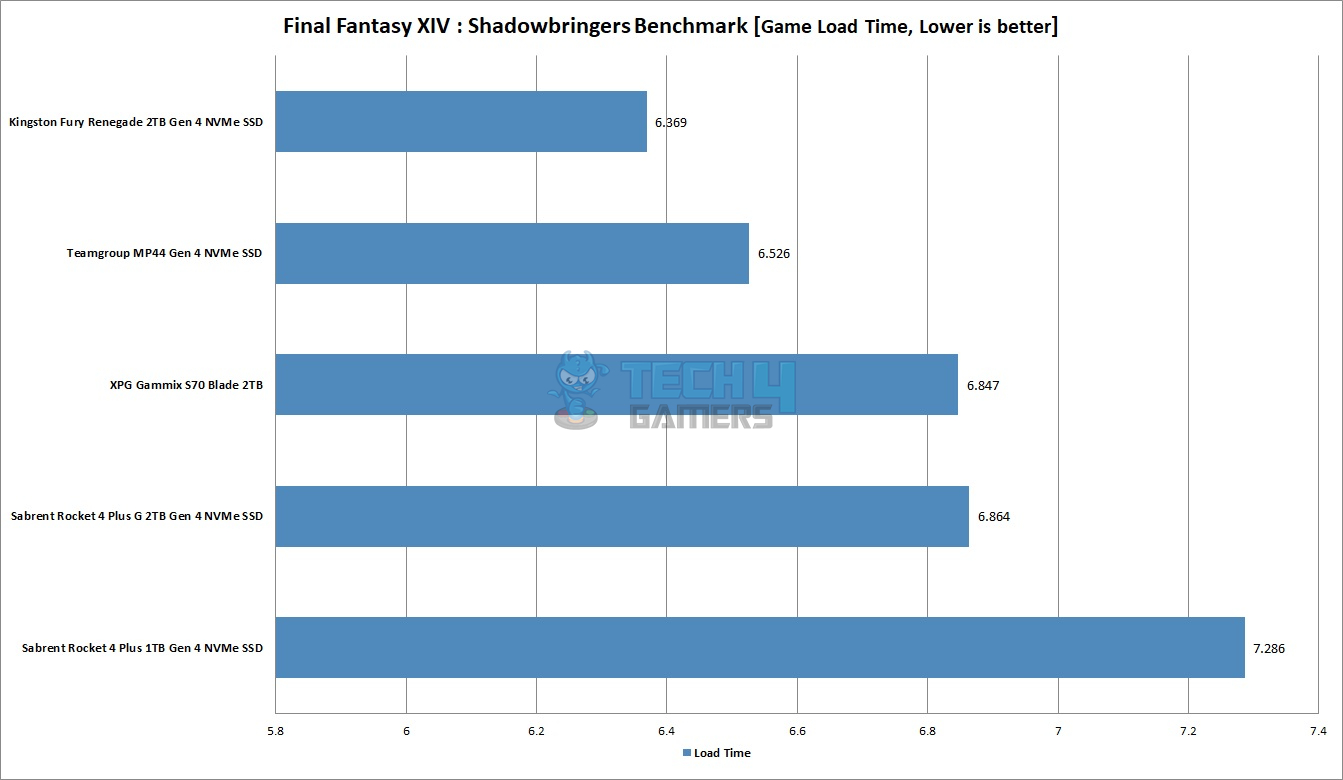
It took 6.847 seconds in total to load the game. Except for the 1TB NVMe SSD, all other NVMe SSDs are in the 6-second range.
Thermals
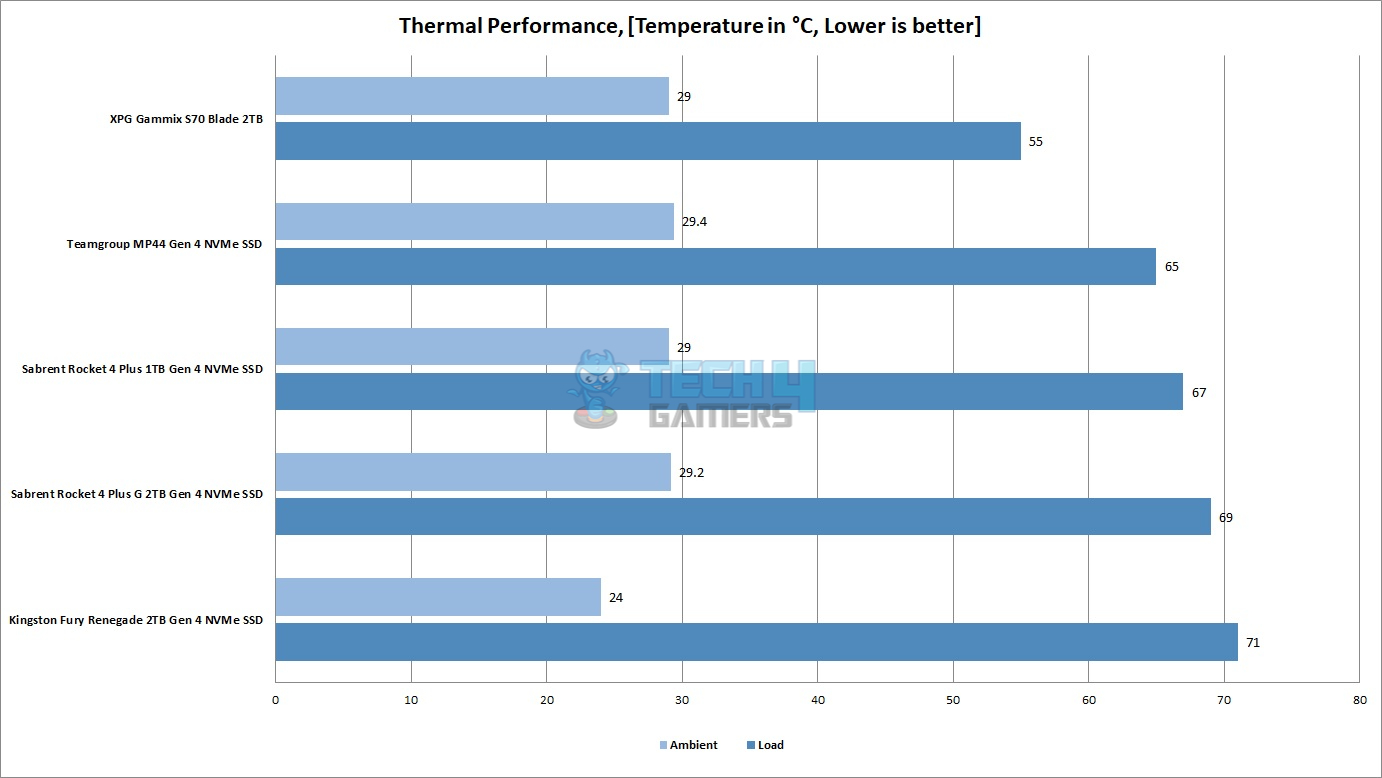
55°C was the maximum temperature recorded when the simultaneous read and write operation of 561GB data was done on this drive. The ambient was 29°C. The SSD was installed under the motherboard’s aluminum heatsink, and there was no airflow since testing was done in open air. This is quite a good performance.
Conclusion
We have tested the XPG Gammix S70 Blade 2TB NVMe SSD in this article. This SSD is based on PCIe Gen 4×4 using NVMe 1.4 interface. It has a form factor of 2280 (22×80) and an M-Key type SSD. This SSD comes with a dedicated heatsink cover, which is nothing fancy, rather a simple 1mm aluminum plate with a 0.5mm thermal pad to keep the temperatures at bay.
We did not test that heatsink, but from the looks of it, it looks like it won’t be enough to cool the Gen 4 NVMe SSDs. This SSD has a 3.2.F.83 firmware, and it supports many important features such as SLC Caching and DRAM cache buffer, Advanced LDPC ECC Technology, E2E Data Protection and RAID Engine, and AES 256-bit encryption support.
The SSD is dual-sided, meaning it has components (Controller, NAND Flash, and DRAM) on both sides of the PCB. The dimension of this SSD is 80x22x3.3mm, where 3.3mm is the thickness of this SSD. This makes the XPG Gammix S70 Blade 2TB NVMe SSD compatible with PS5, which can accommodate up to 11.5mm thick SSDs.
This thickness would be 4.3mm after installing the heatsink cover. XPG has mentioned that the provided heatsink will bring the temperature down by up to 20%. We can’t confirm or deny this because we have tested this SSD under the motherboard’s M.2 heatsink.
The main driving force of this SSD is the IG5326 PCIe 4×4 controller from INNOGRIT. XPG uses 176-layered 3D NAND Flash from Micron. There are a total of 4 chips, each having 512GB size. There are two DRAM memory chips, each 1GB in size. These are Samsung chips rated at 2666MHz. Two NAND Flash, a DRAM, and the controller are installed on the top of the PCB. The backside of the PCB has two NAND flash and a second DRAM chip.
The 2TB variant of the S70 Blade series is rated for up to 7400MB/s in sequential reads and up to 6800MB/s in sequential writes. Please note that installing the 2TB version in PS5 would limit the speed rating to 6100MB/s. The 4K Random reads and writes are rated for up to 750K IOPS. The TBW rating is 1480. The MTBF is 2,000,000 hours. The operating temperature range is 0°C to 70°C. XPG has provided powerful and comprehensive software named SSD Tool Box that can be downloaded from their website. This software allows secure erase, TRIM command, cloning, running diagnostic scans, firmware updates and so much more.
The XPG Gammix S70 Blade 2TB NVMe SSD has performed wonders in our overall test suite. We have seen it lacking in a few benchmarks, but its sheer performance in other benchmarks and particularly in real-world testing (that matters most) has shown a remarkable overall performance. The drive also passed its rated 4K Random read and write speeds. It was not throttling even under extreme testing where simultaneous reads and writes were made on it at a time. The maximum temperature was 55°C at an ambient of 29°C, which is too good to have.
This drive is retailing at USD 109 at the time of this writing. This makes approximately 18 cents per GB for this drive, making it a good value for the gamer and a general user. You just can’t get a good deal on a 2TB drive better than this. Yes, Teamgroup MP44, which is the best allrounder, retails at USD 92, but it is a DRAM-less SSD, and our testing has shown that the XPG drive has outclassed the MP44 in real-world testing. For me, this is a stellar performance and an excellent value from the XPG Gammix S70 Blade 2TB NVMe SSD. XPG is offering a 5-year warranty on this drive as well.
Thank you! Please share your positive feedback. 🔋
How could we improve this post? Please Help us. 😔
[Hardware Reviewer & Editor]
Meet Nauman Siddique, a highly experienced computer science graduate with more than 15 years of knowledge in technology. Nauman is an expert in the field known for his deep understanding of computer hardware.
As a tech tester, insightful reviewer, and skilled hardware editor, Nauman carefully breaks down important parts like motherboards, graphics cards, processors, PC cases, CPU coolers, and more.
- 15+ years of PC Building Experience
- 10+ years of first-hand knowledge of technology
- 7+ years of doing in-depth testing of PC Hardware
- A motivated individual with a keen interest in tech testing from multiple angles.
- I majored in Computer Science with a Masters in Marketing
- Previously worked at eXputer, EnosTech, and Appuals.
Get In Touch: [email protected]



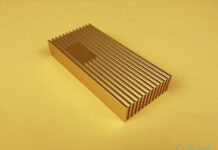
![BEST SSD For PS5 In 2023 [Our Top Picks] Best M.2 SSD For PS5](https://tech4gamers.com/wp-content/uploads/2023/08/Best-M.2-SSD-For-PS5-218x150.jpg)
![6 BEST SSD For Gaming In 2023 [Tested] Best SSD For Gaming](https://tech4gamers.com/wp-content/uploads/2023/08/Best-SSD-For-Gaming-218x150.jpg)
![Adata XPG Spectrix D41 Review [Benchmarks & Unboxing] adata xpg spectrix d41 review](https://tech4gamers.com/wp-content/uploads/2018/08/adata-xpg-spectrix-d41-review-218x150.jpg)
